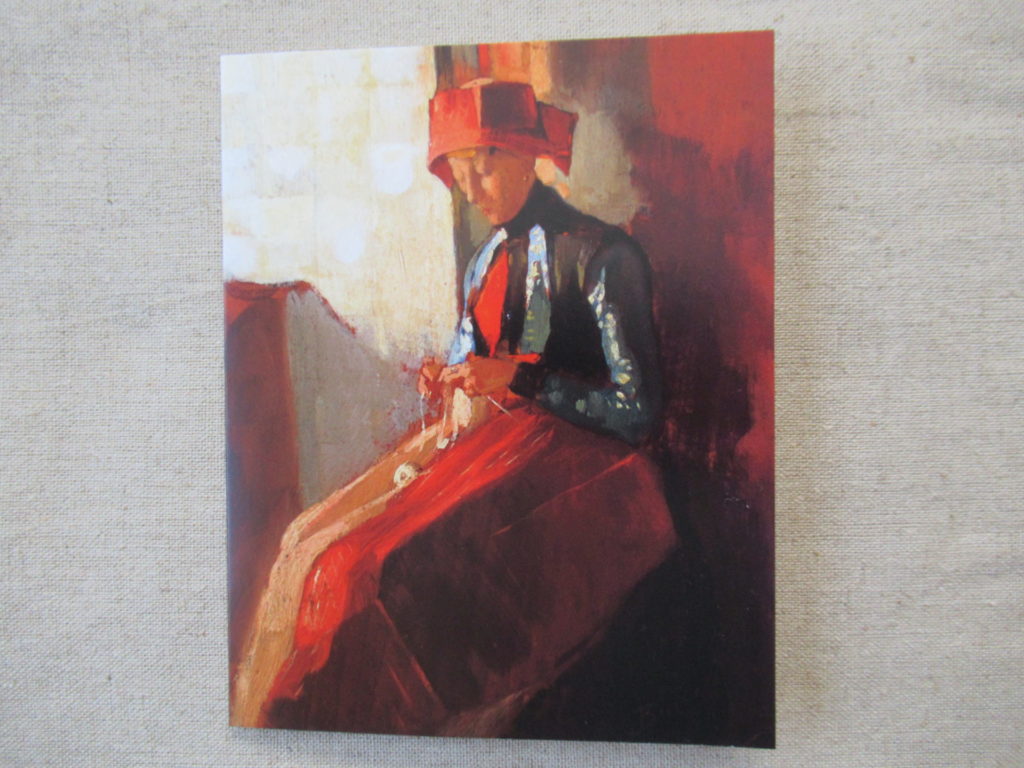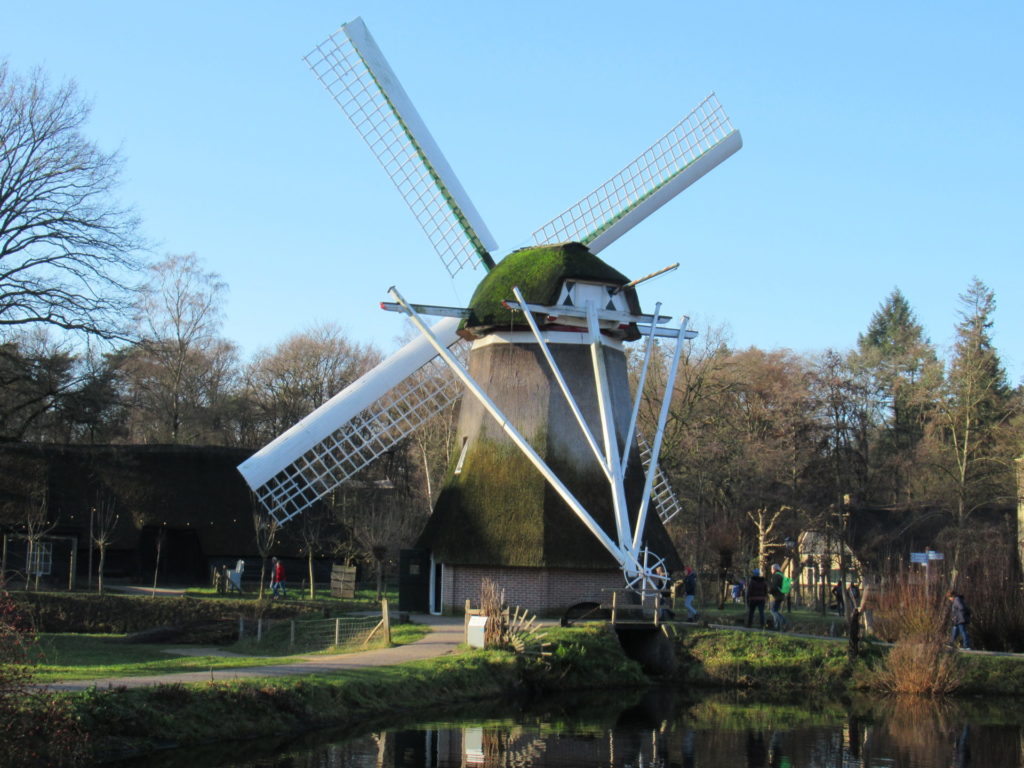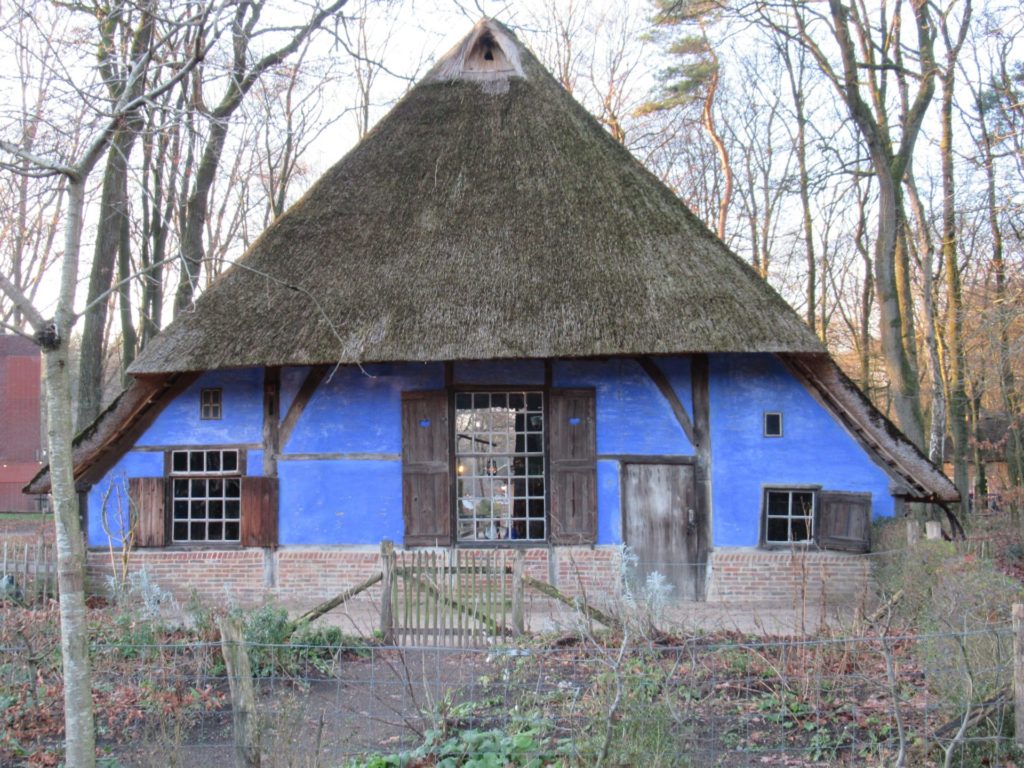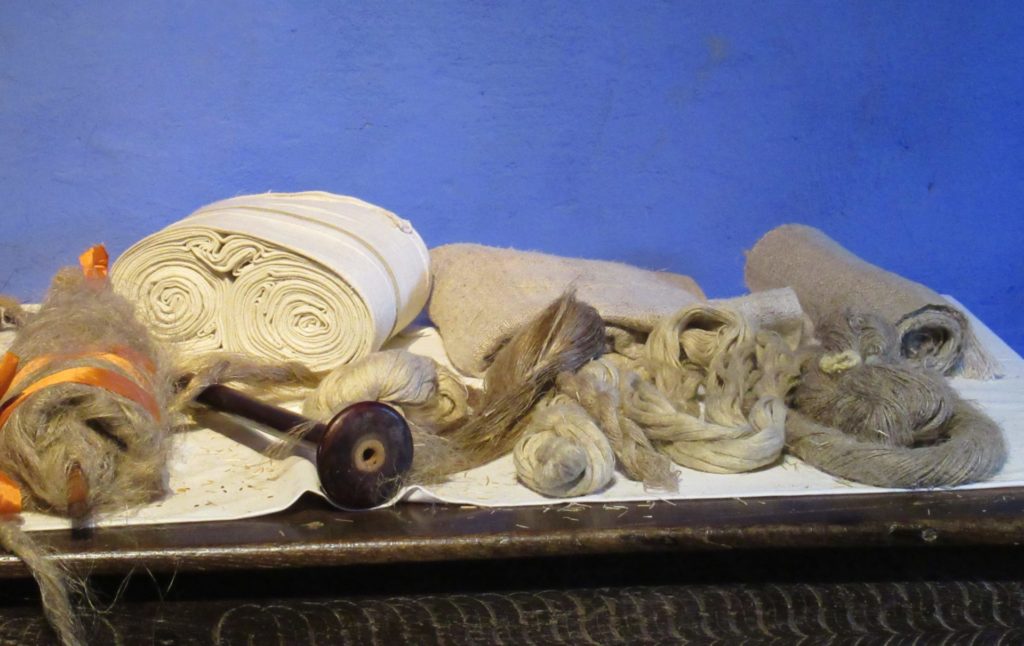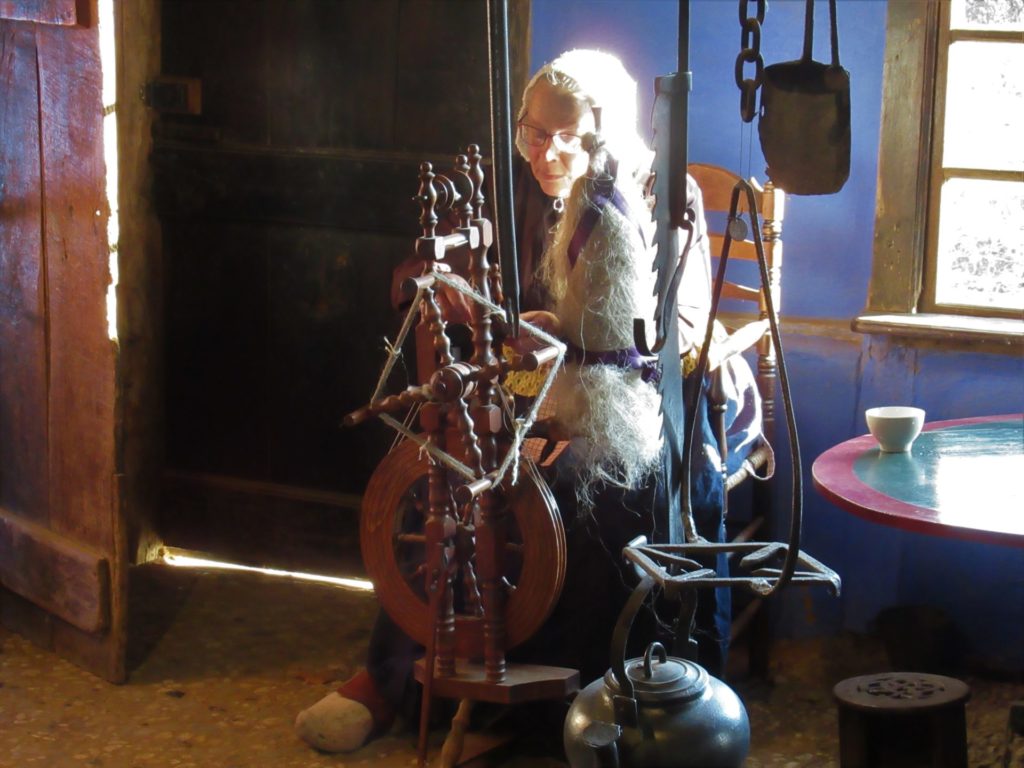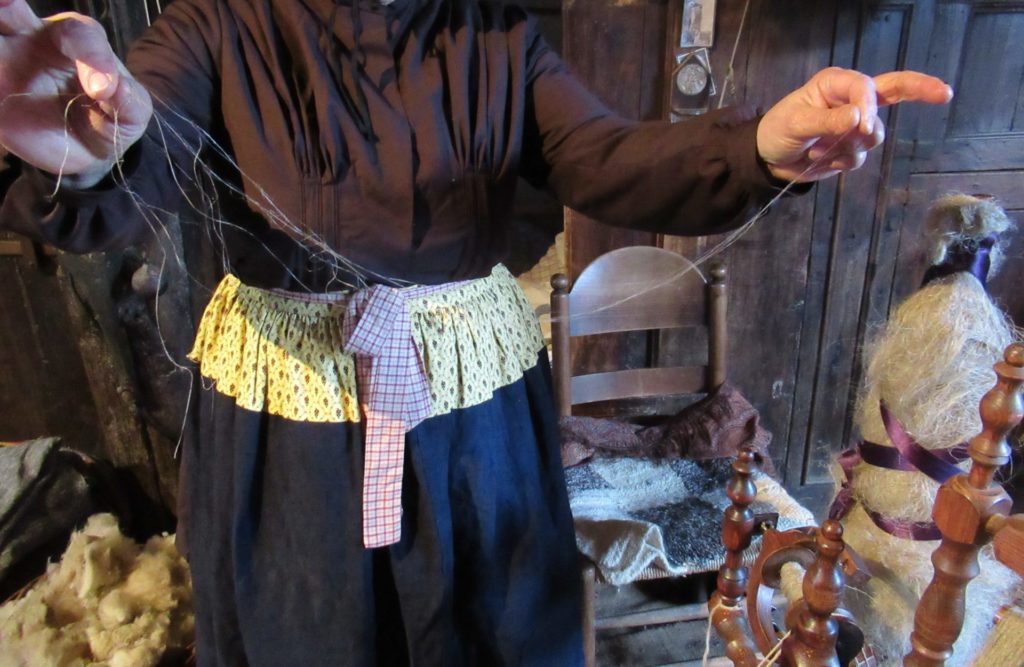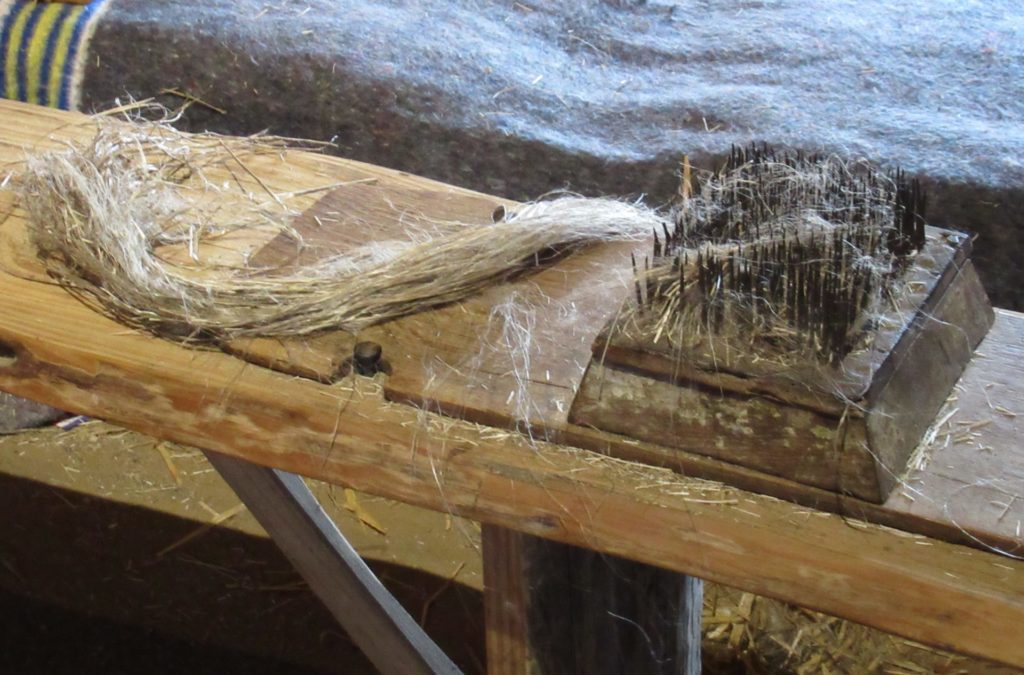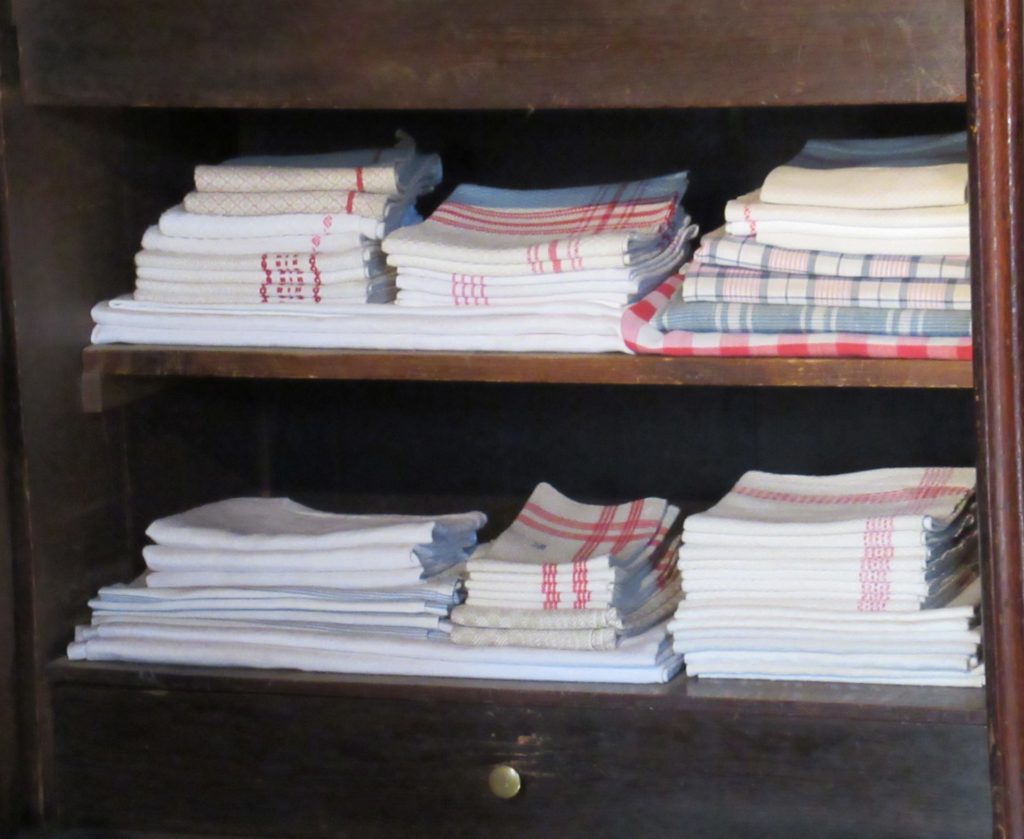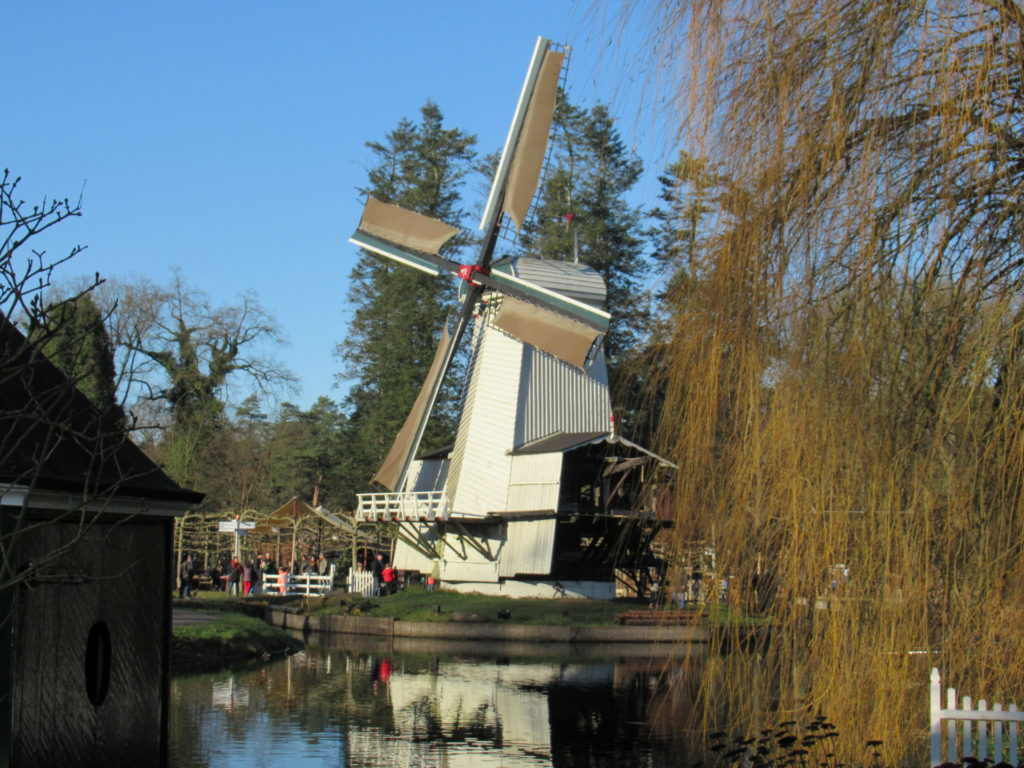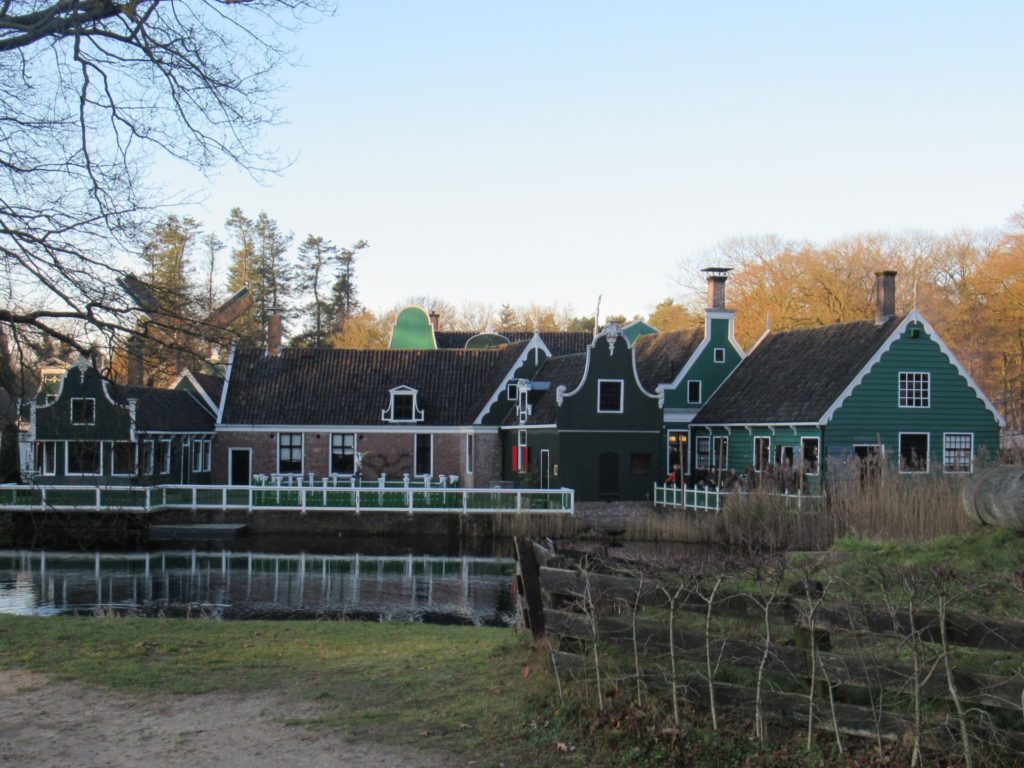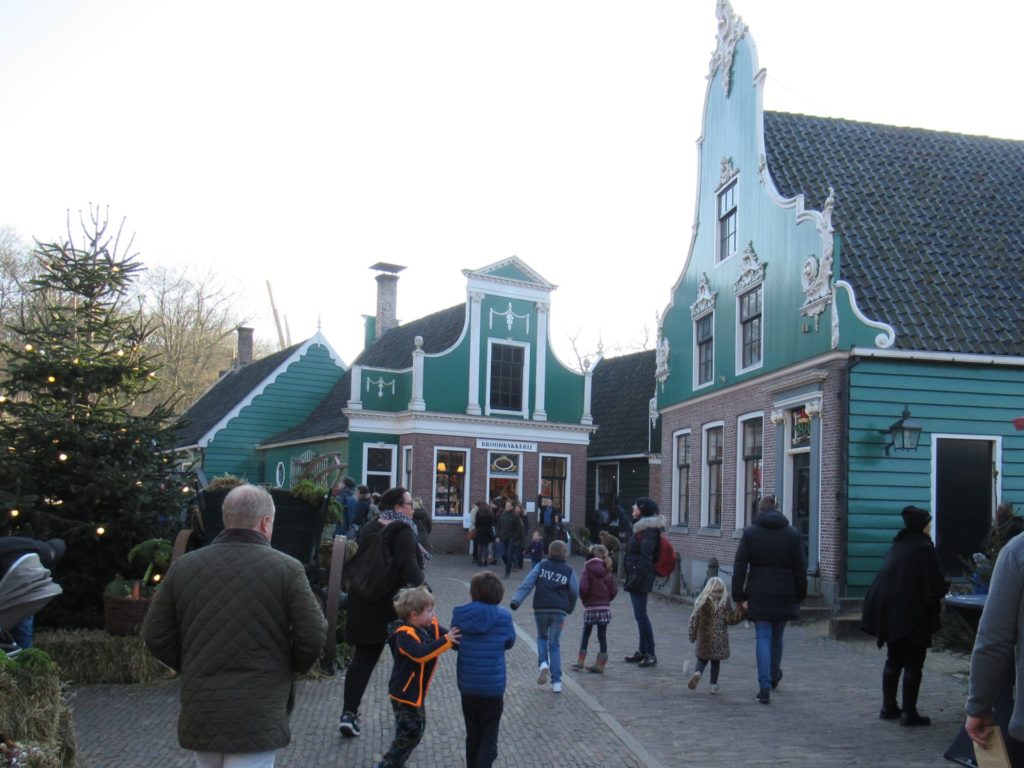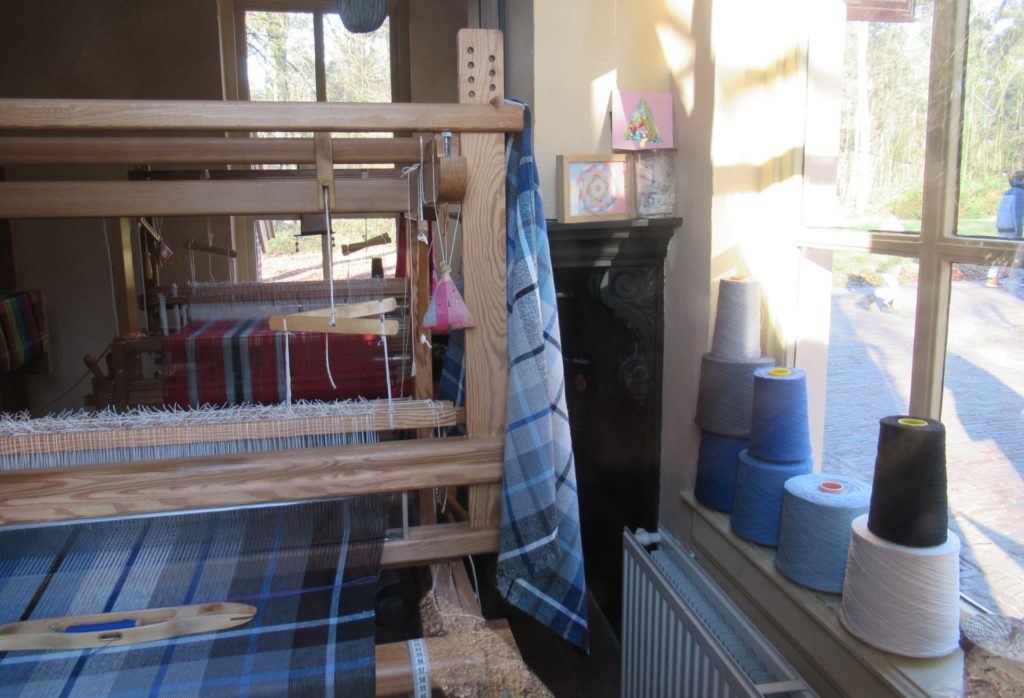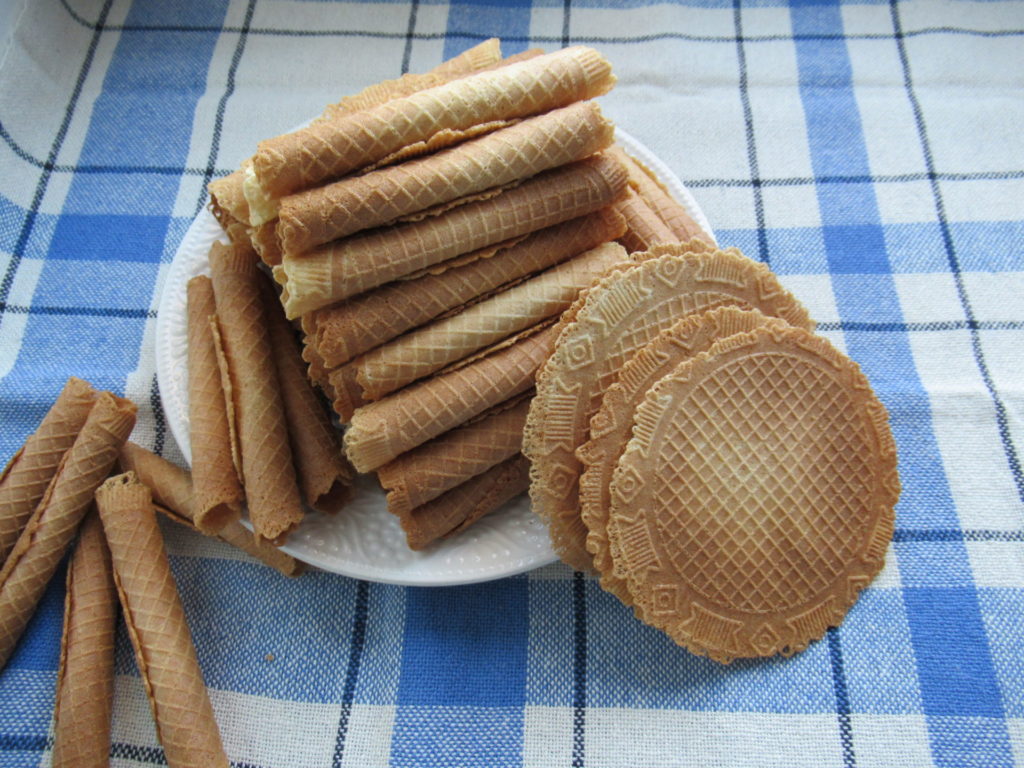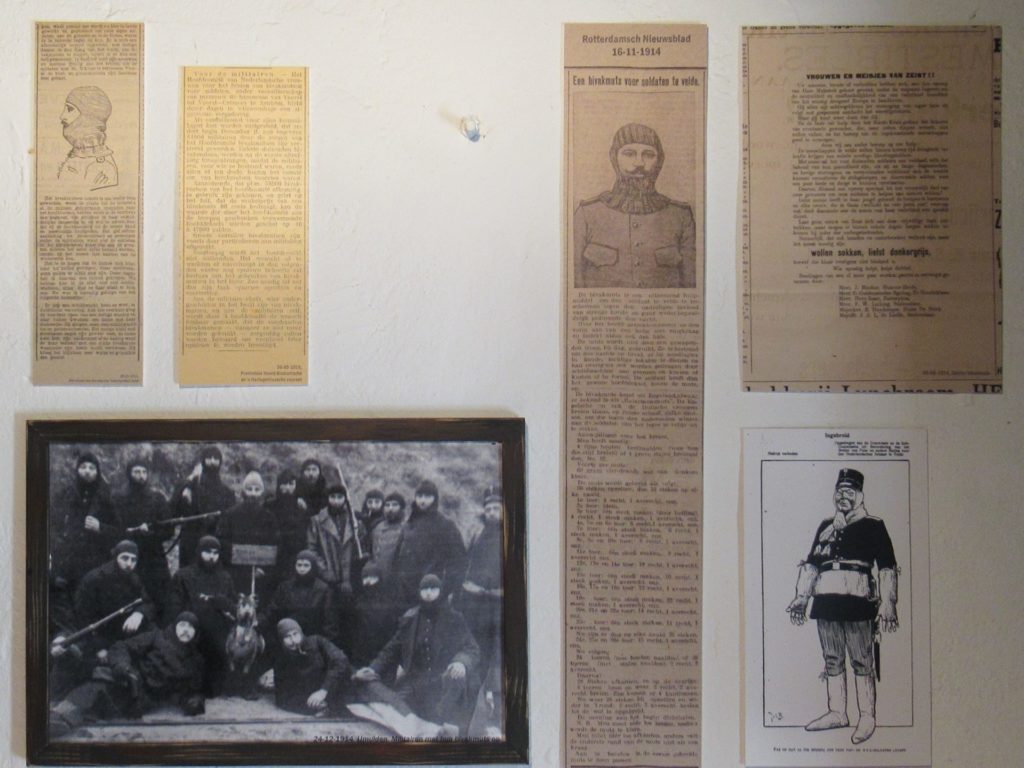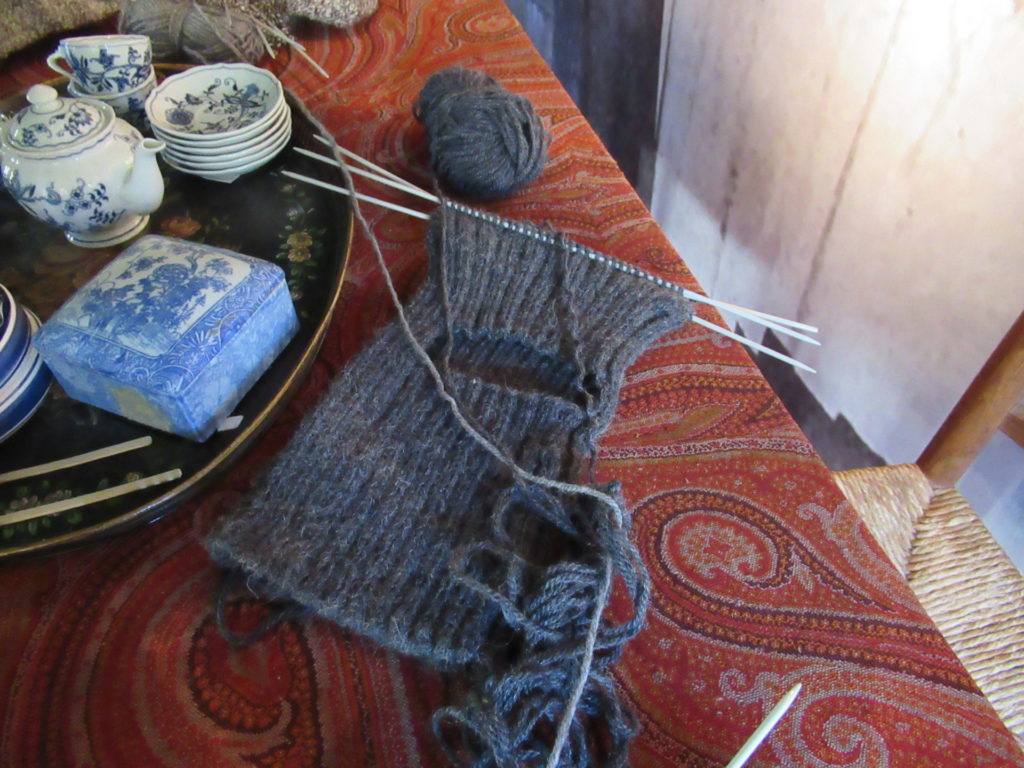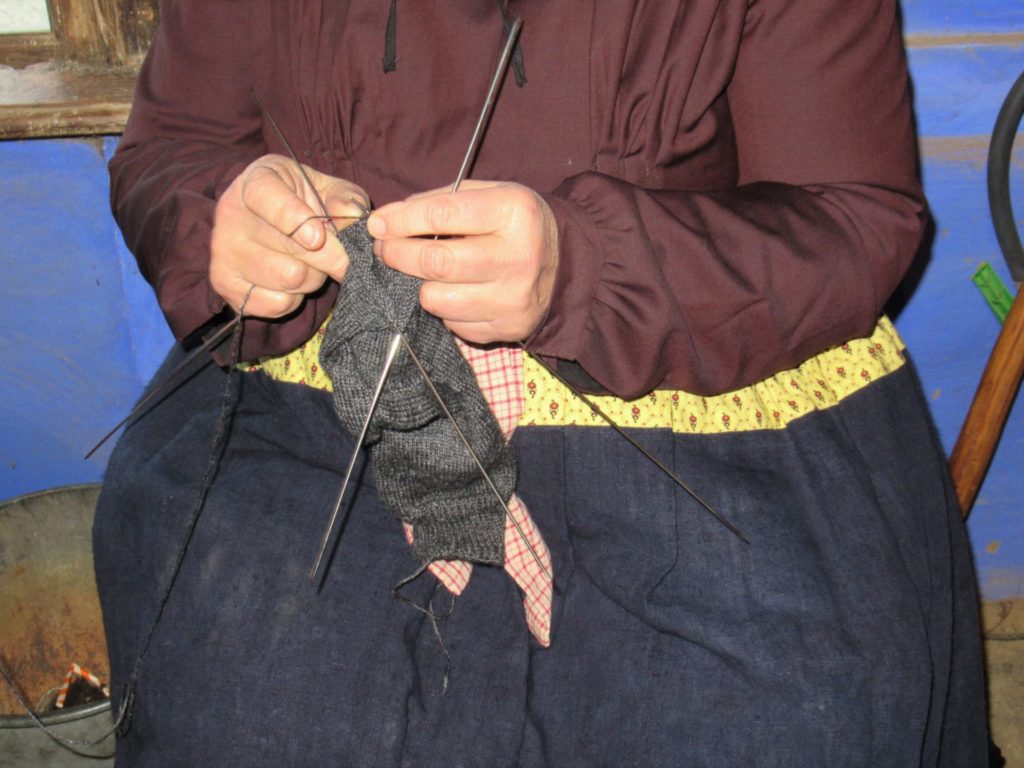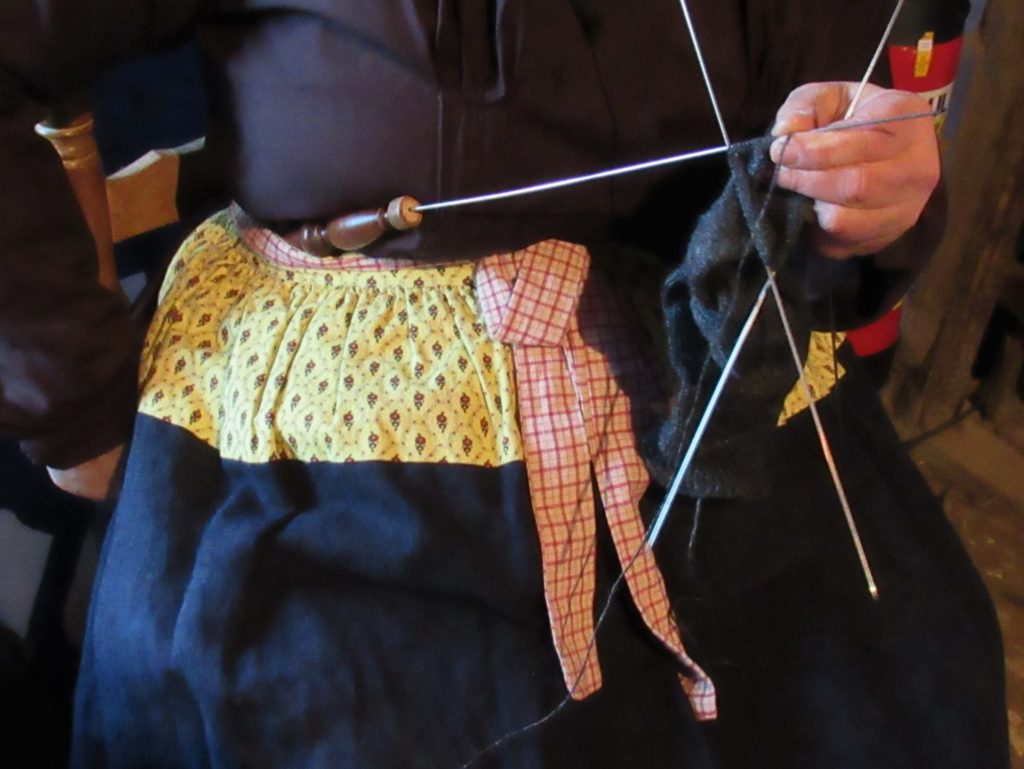history
Stunning Socks
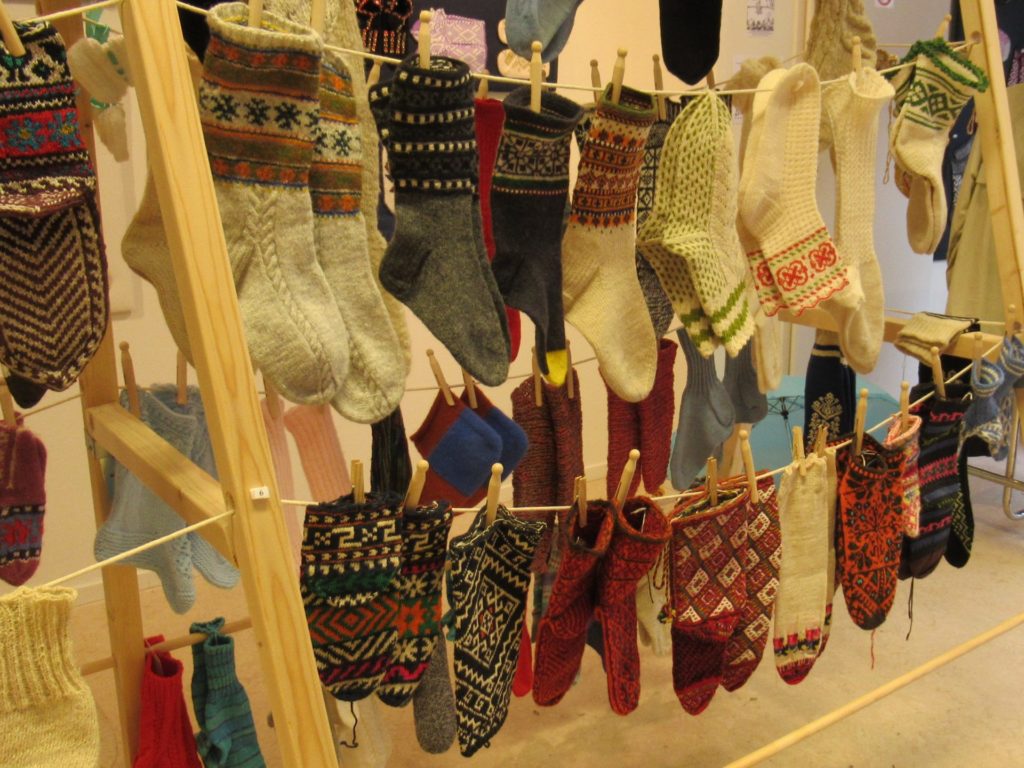
Washing line upon washing line filled with colourful handknit socks greeted me as soon as I opened the door. A cheering sight on a dismal day. We’re back at the same exhibition at the Textile Research Centre in Leiden where I saw the stockings I wrote about last week.
Today I’m focusing on the huge variety of socks on display. Old socks, new socks, simple socks and intricate socks. There were socks with separate toes:
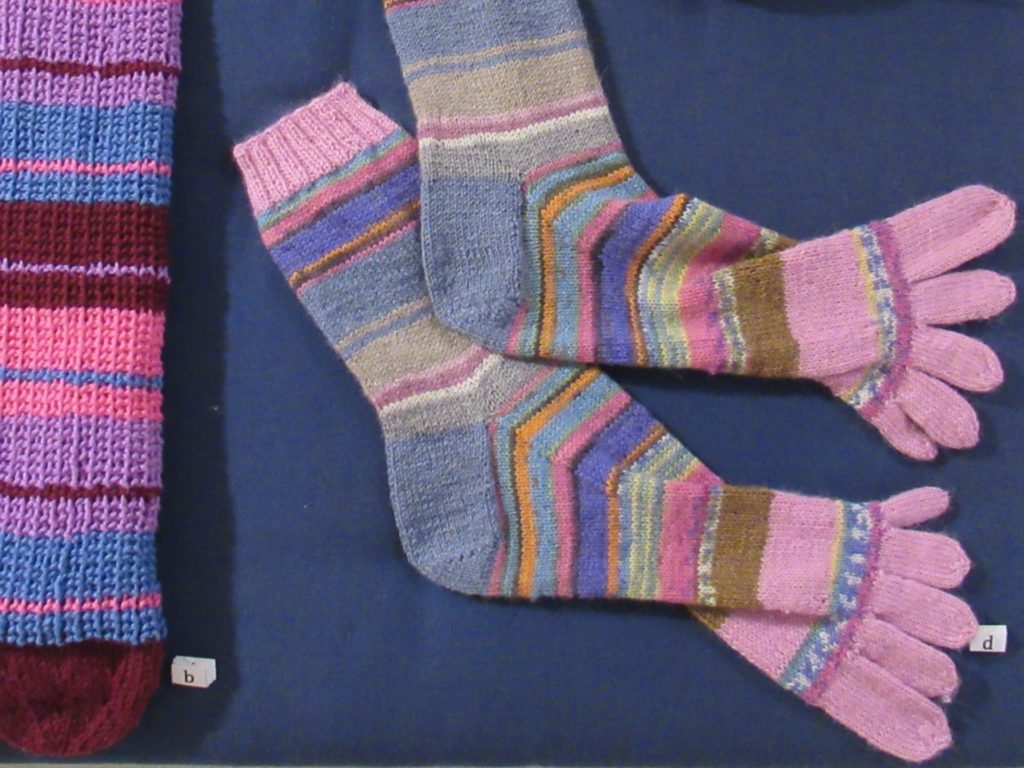
Fun, but apart from the toes, fairly simple.
On the other end of the spectrum there was a very, very elaborate pair from Tajikistan (below). The baby booties next to them give an indication of their size. They’re huge! And they don’t even look much like socks at all.
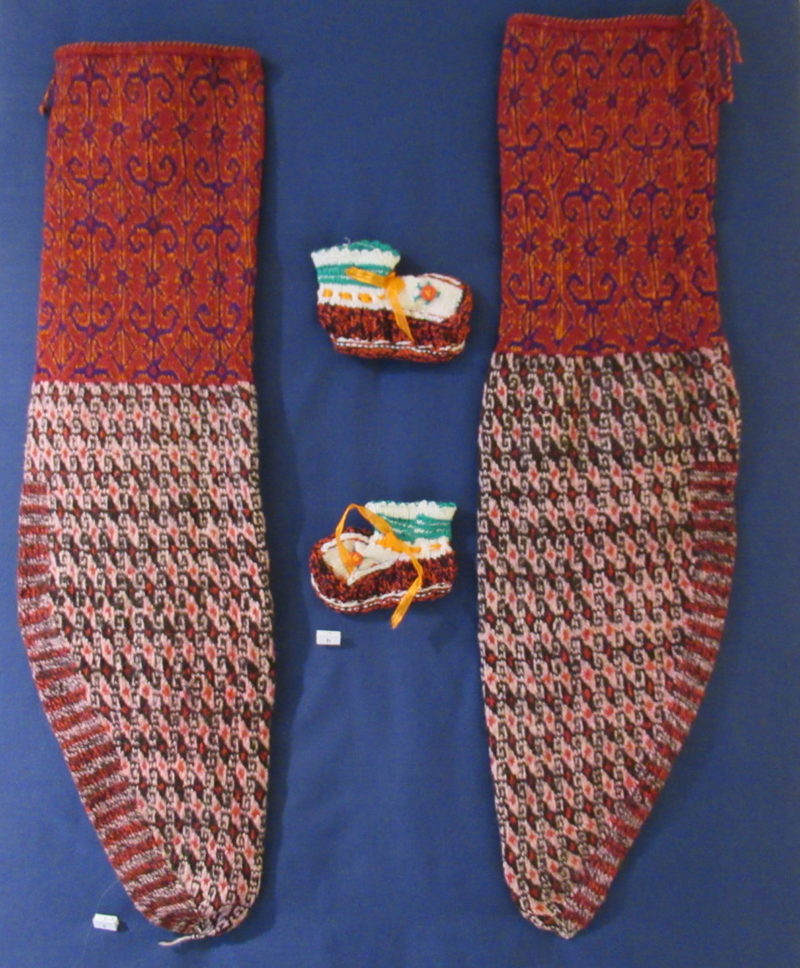
The information sheet says that these kind of socks ‘sometimes reached halfway up the thigh’ and ‘were held in place by tying them at knee height with a woollen cord or belt, or by pulling on the knitted threads at the top.’
The sheet also gives us information about the way the yarn was dyed, the names of some of the motifs and the knitting techniques used.
For a knitter, the wonderful thing about this exhibition is the wealth of information provided about materials, patterns and techniques.
Speaking about techniques, there was a board with examples of over 20 different ways to knit sock heels.
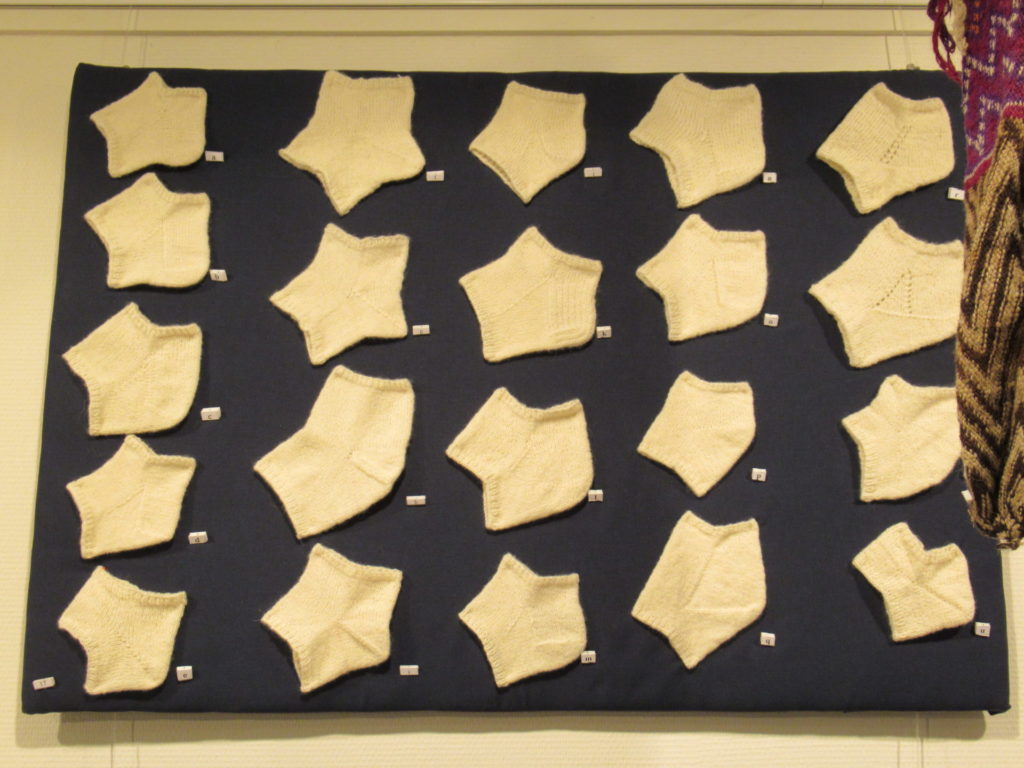
And as for patterns, just look at this cascade of stockings from Norway:
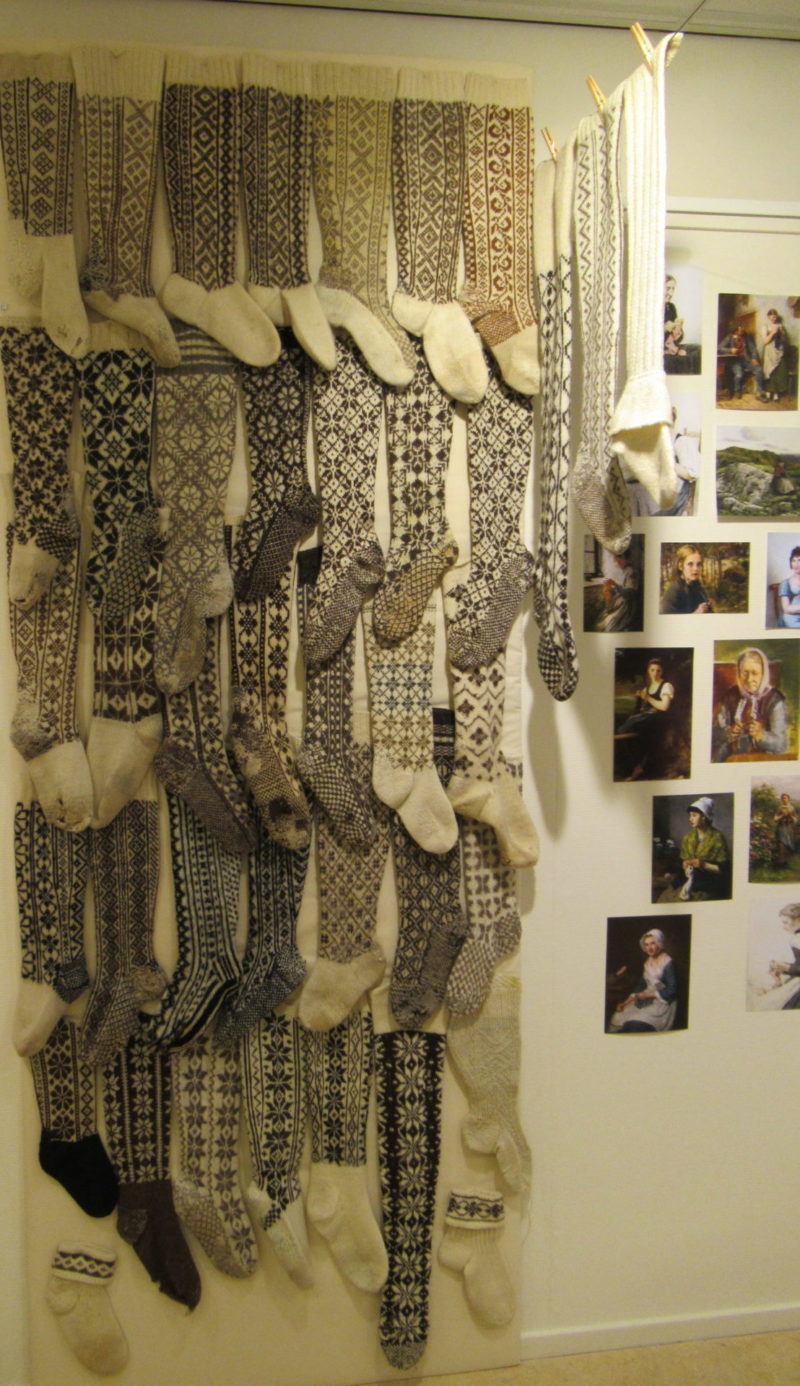
From floor to ceiling, they’re all knit in neutral, natural colours. Still, they are all different because of the patterns used. Many of them (or perhaps even all of them?) have variations of a pattern called ‘åttabladsrosa’ or eight-pointed star.
Some are covered entirely in a pattern, including the foot. And some of them have a plain, unpatterned foot. Why knit a complicated pattern when it is hidden inside a shoe anyway? Or perhaps the foot was re-knit in a single colour because it was worn out?
These stockings are just a small part of Annemor Sundbø’s collection, or her ‘rag pile’, as she calls it. If you’d like to hear more, she is giving a lecture at the TRC on December 18th 2019. There’s more information here (please remember to register beforehand).
Looking closely at these stockings, you can see that they are well worn and that some of them have been mended…
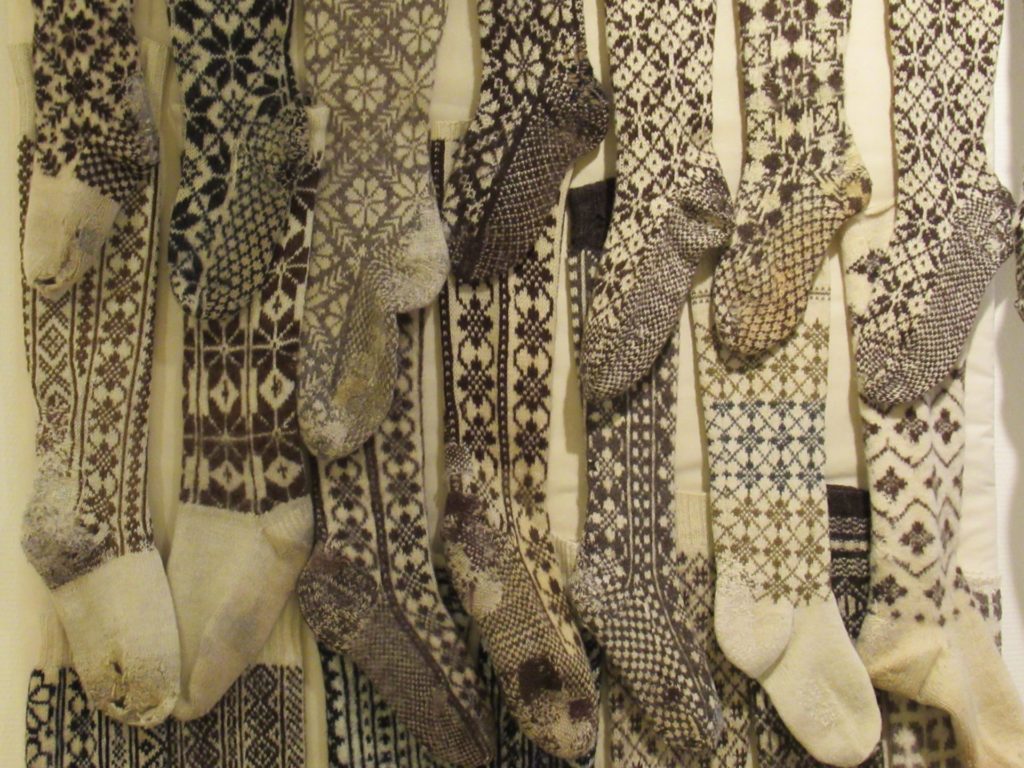
… which brings us to the mending corner.
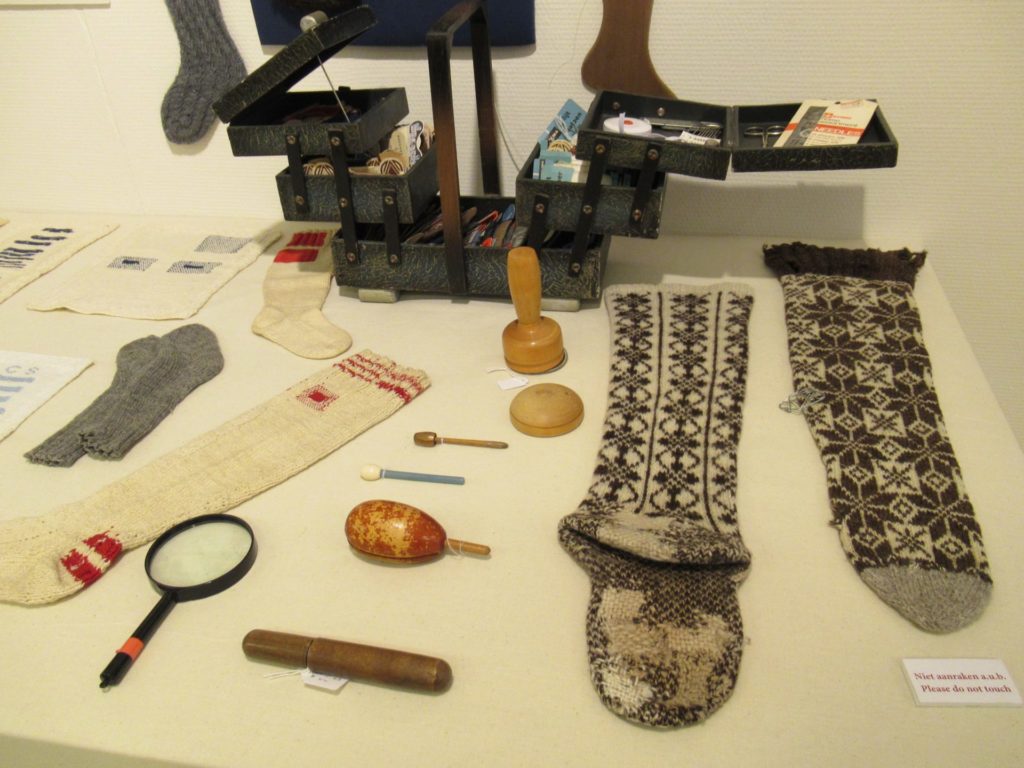
What I loved about this exhibition was its friendly, open accessibility. There are several signs telling us not to touch things, but nothing is behind glass and everything can be studied in detail from close up.
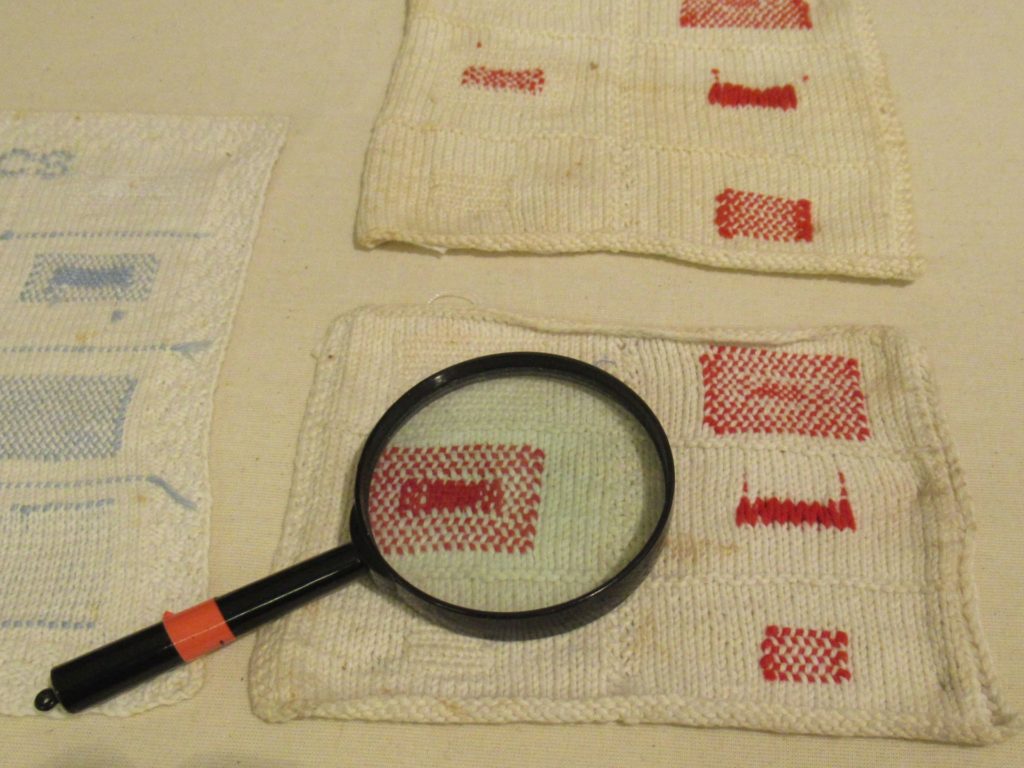
I zoomed in on the bit of blue mending you can see below. I learnt the weaving technique in the middle of the two rectangles at the top from my Mum. But the technique around it and in the two rectangles below, picking up alternately the left and right leg of the knit stitch, is new to me.
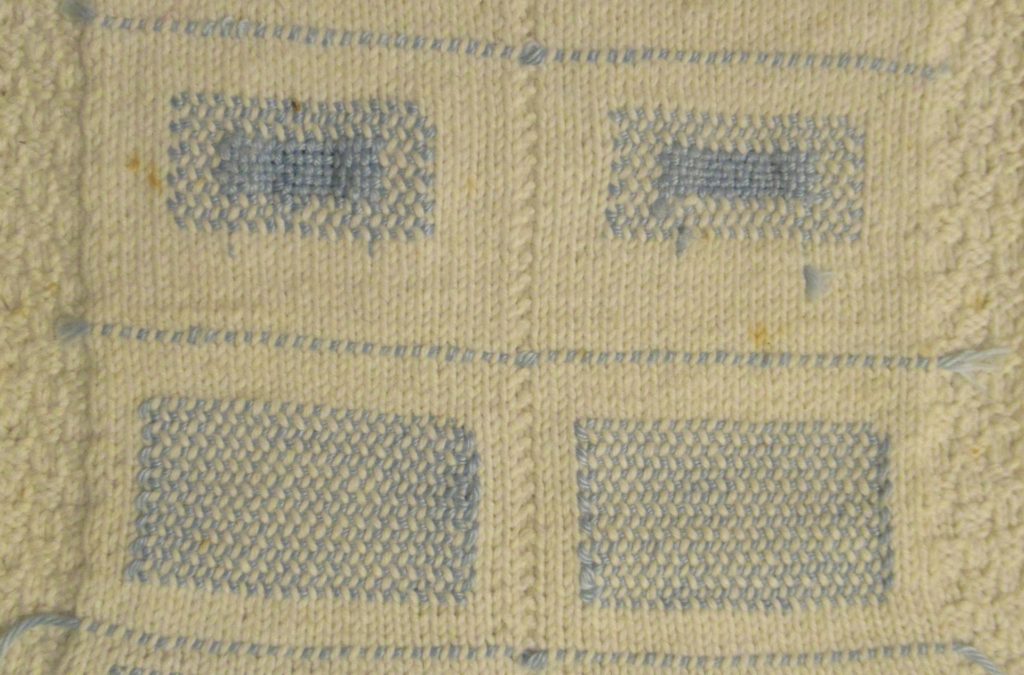
Apart from new things to learn, there was also a lot of inspiration to be found. There were many motifs and other elements that I could use in my own knitting. Take for instance the pattern on the foot of a pair of socks from Iran:
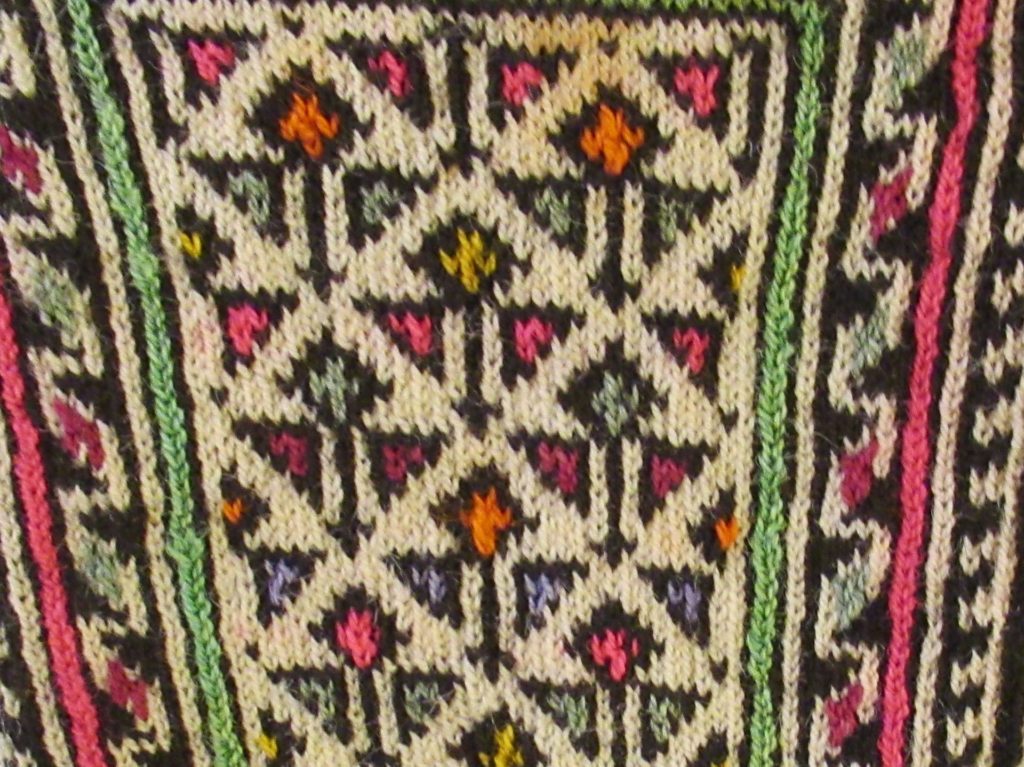
The black shapes filled with bright colours could easily be multiplied into an all-over pattern for a larger surface.
And one or more of the bands on the cuff would make a lovely border for all kinds of projects.
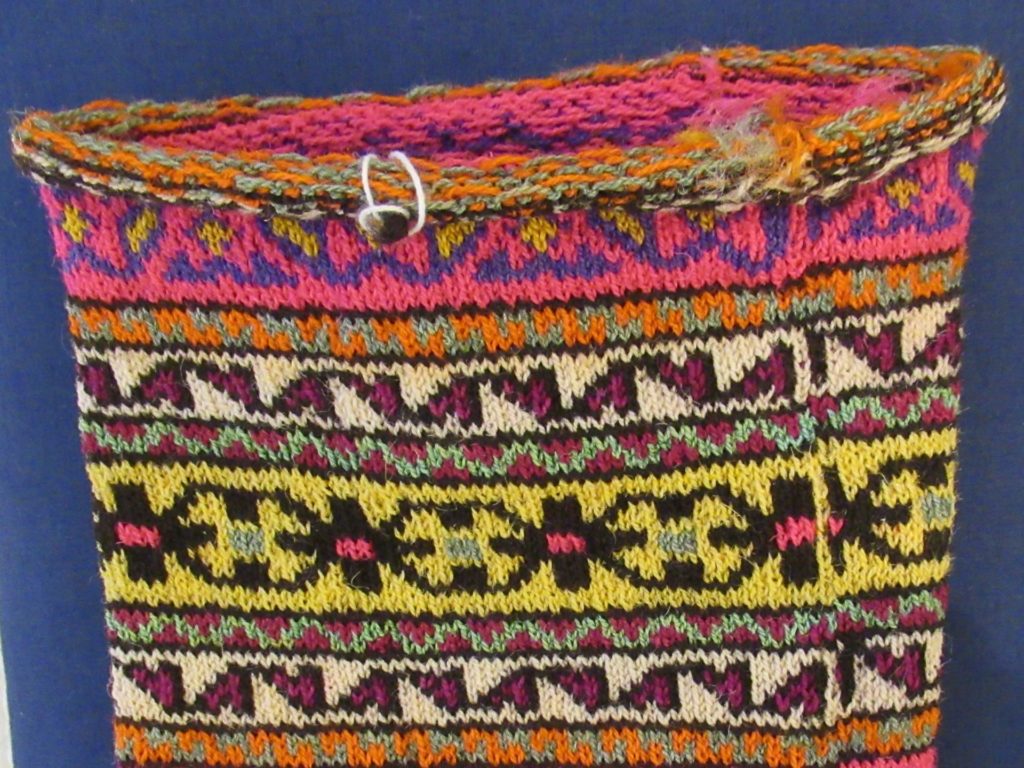
For more inspiration, there were three colourful samplers with many beautiful patterns:
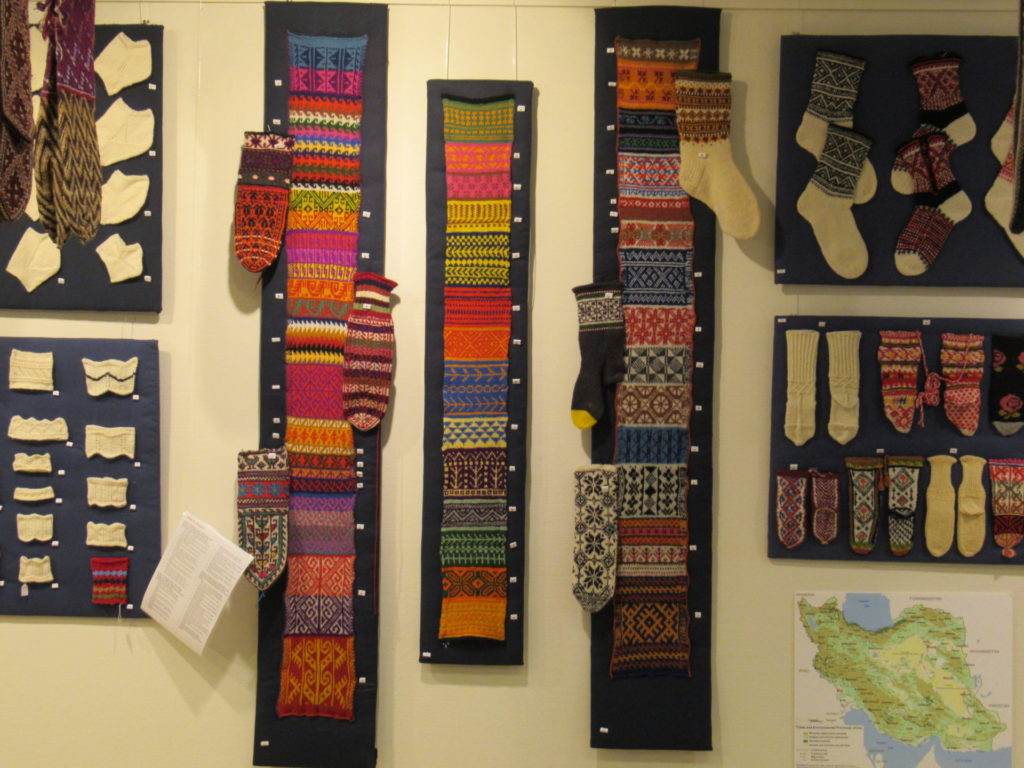
Very, very inspiring. And humbling too. We tend to think that we’re always making progress, knowing more, doing things better and more efficiently. We can certainly produce socks more efficiently. But for the rest, we’re fortunate to have museums and other centres to preserve the knowledge and expertise about making things by hand for us.
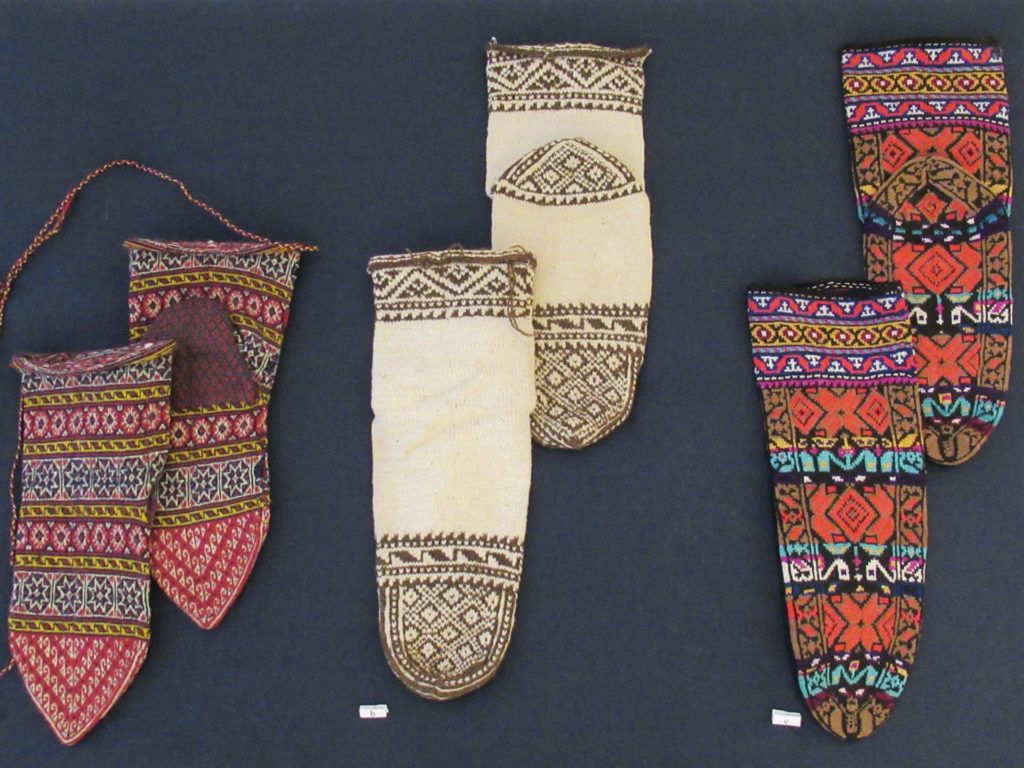
I’ve only given you a taster of the exhibition here. You can still visit to see more if you don’t wait too long – it’s open until the 19th of December. And if you are unable to go, because you can’t find the time in the busy month of December, have the flu or live too far away, there’s always the TRC website. Their online collection catalogue can be viewed at any time or place.
My day in Leiden has given me much inspiration and food for thought. In addition to visiting the sock exhibition, I also took a needle binding workshop on the same day. I need to digest everything I learnt there before I can write about it, but you’ll probably hear more about that later.
Shipwrecked Stockings

Early one morning last week. It was still dark. The first raindrops started to fall as soon as I left home. Before I had cycled to the end of our street it was bucketing down, and by the time I reached the railway station, I felt like a drowned cat. How fitting. I was on my way to Leiden, to visit an exhibition about some of the finds from a shipwreck.
It must have been a day just like this when, somewhere around 1650, a ship filled with trade goods from the Mediterranean sank off the coast of the Island of Texel. About 360 years later, a group of divers found the wreck. They discovered that it contained a load of boxwood and resins, but also many luxury items, like Italian pottery, an elaborately decorated silver gilt goblet, and a leather book cover embossed with the crest of the House of Stuart.
Most exciting of all were the textiles that were found, perfectly preserved by the sand that had covered them for centuries. Among them were a gorgeous silk dress and a pair of silk stockings. It is these stockings that the exhibition I was visiting was about. The original 17th Century stockings were not on display, but replicas of them, like the ones you can see at the top of this post and these:
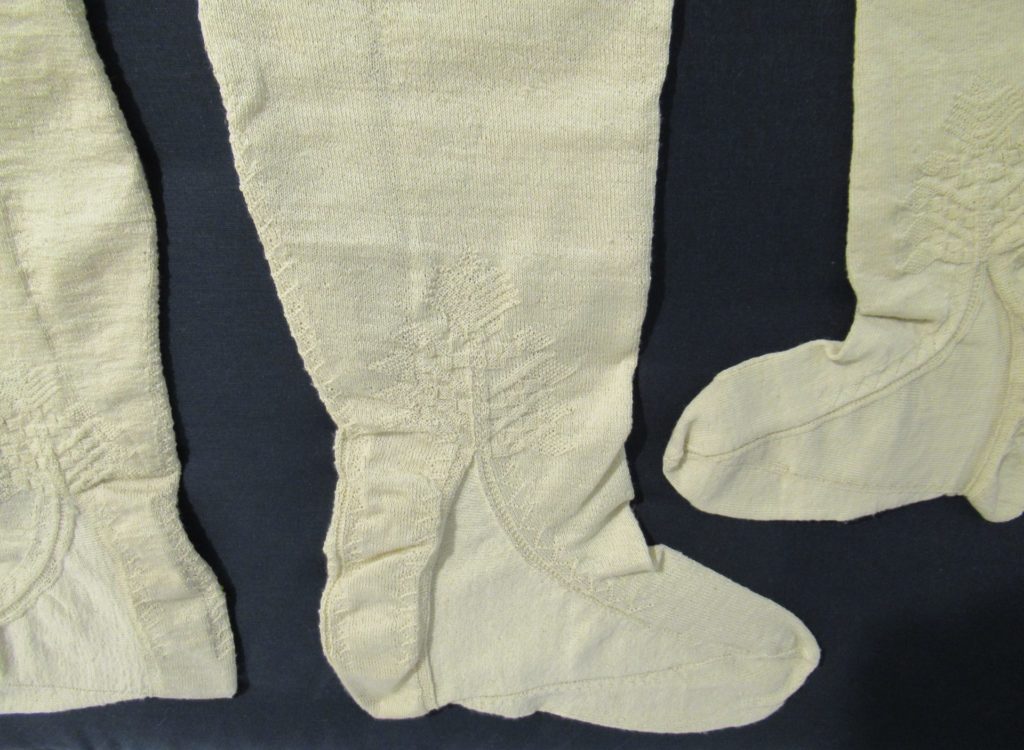
So, why would I travel all the way to Leiden (20 minutes cycling through pouring rain, 2 hours by train, 15 minutes by bus) to see some replicas of stockings? I hope you’ll understand by the end of this post.
For me, it all started a year or two ago, when I read about a citizen science project involving knitting. I attended a lecture by archaeologist Chrystel Brandenburgh, describing the shipwrecked stockings and the idea of recreating them to find out more about the materials and techniques used at the time they were made and who they may have belonged to. My interest was piqued, but when I heard about the very thin needles that would be used, and had estimated approximately how much time it would cost me to knit one of these stockings, I chickened out.
Other people had more pluck. Over a hundred experienced knitters from the Netherlands and abroad took part in the project. They started by knitting swatches.

They tried out different types of silk thread to find out what came closest to the original stockings. They were faced with questions like ‘should the silk be degummed before or after knitting?’ Silk contains a natural gum, called sericin, that needs to be removed for the silk to become soft and shiny. I didn’t know that. It is one of the things I learnt from the exhibition.
That’s one of the reasons I’m glad I went – there’s so much to see and learn. I loved the magnifiers dotted about the place, through which I could study the tiny details.
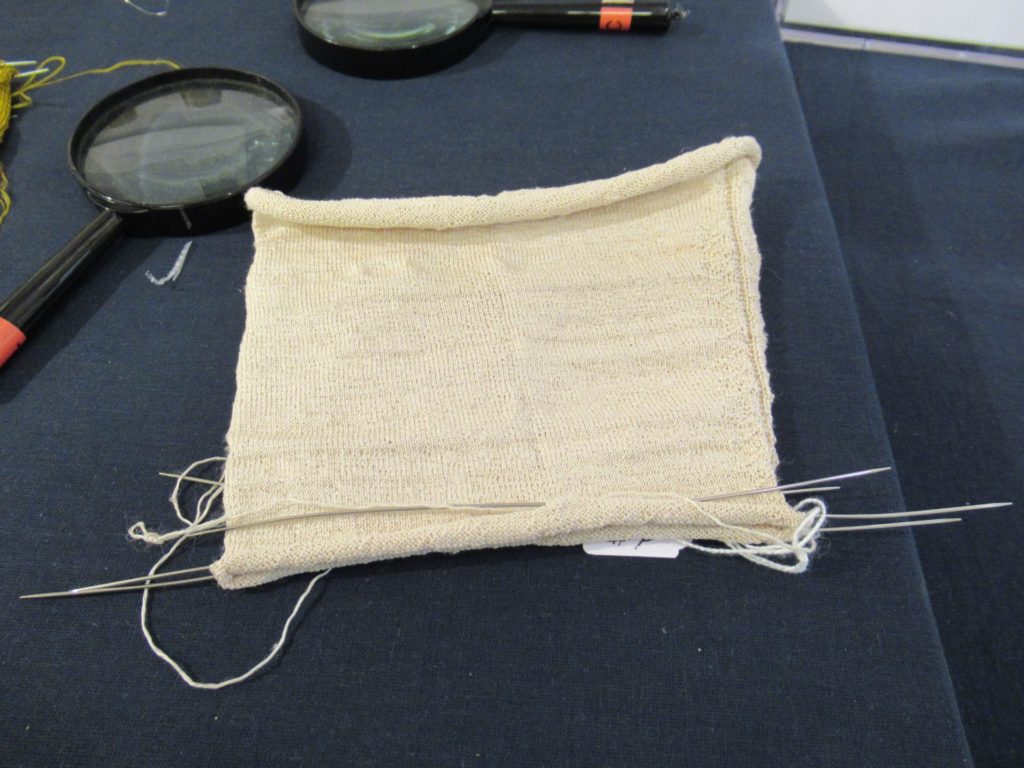
The needles the knitters used were very, very thin, from 0.7 to 1.0 mm (US 000000 to 00000). I heard that it took them on average 240 hours to finish one stocking. Two-hundred-and-forty hours to finish ONE stocking! I can quite understand that they didn’t all manage to actually finish theirs. The unfinished stockings were not a waste of time, though. Even the unfinished ones yielded valuable information.
Together, the knitters and researchers studied the needles and materials used, and also the stitch patterns. The stockings were mainly knit in stocking stitch, but had a kind of fake ‘seams’ decorated with purl stitches.
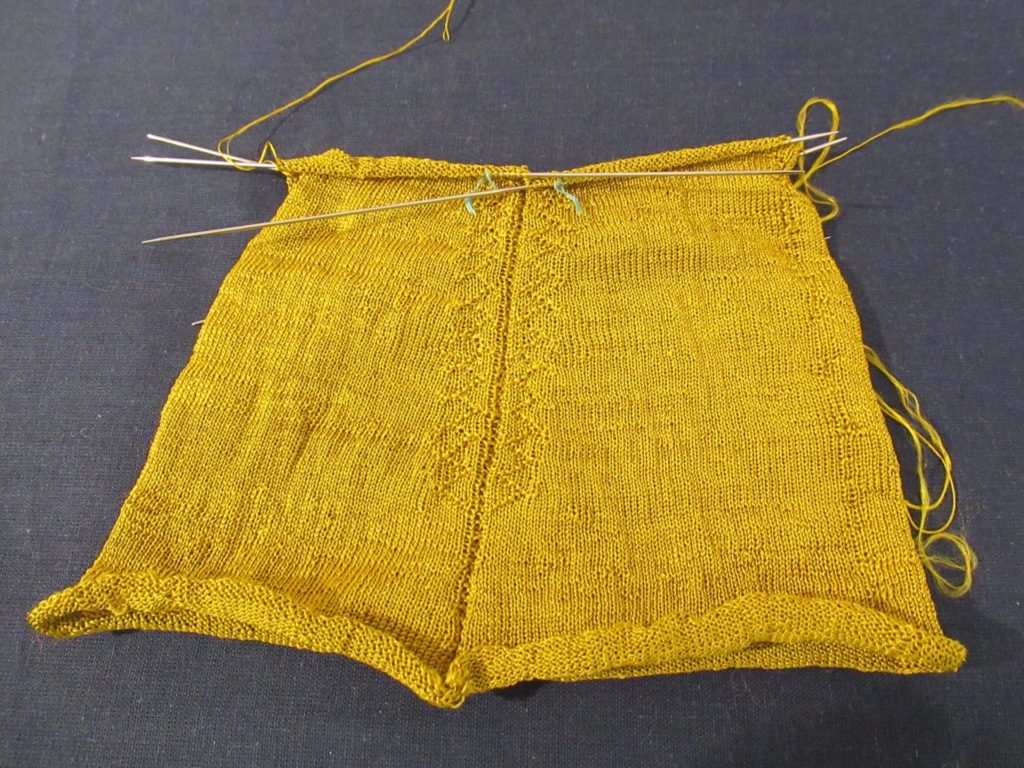
And they had a tree of life motif at the top of the gusset.
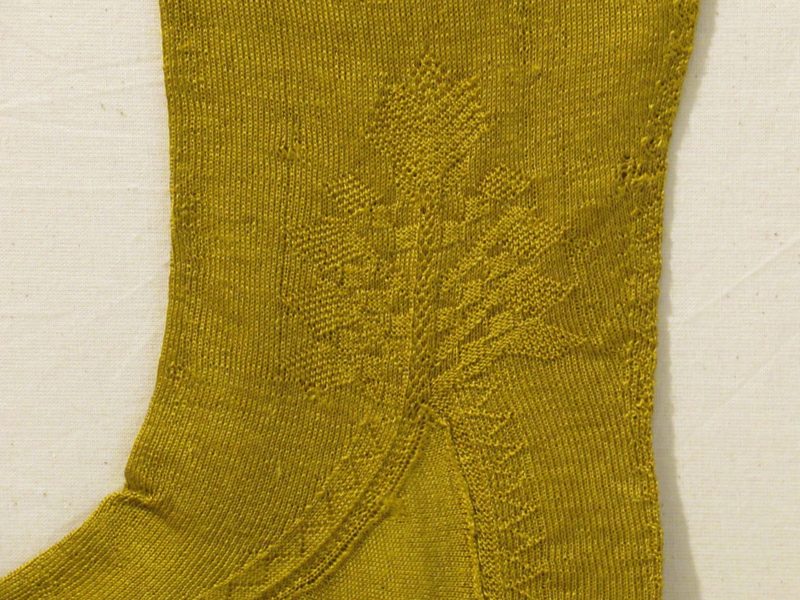
Most of the stockings I saw were off-white, but some were coloured. I don’t know why and how. There was so much information there, that I missed some of it.
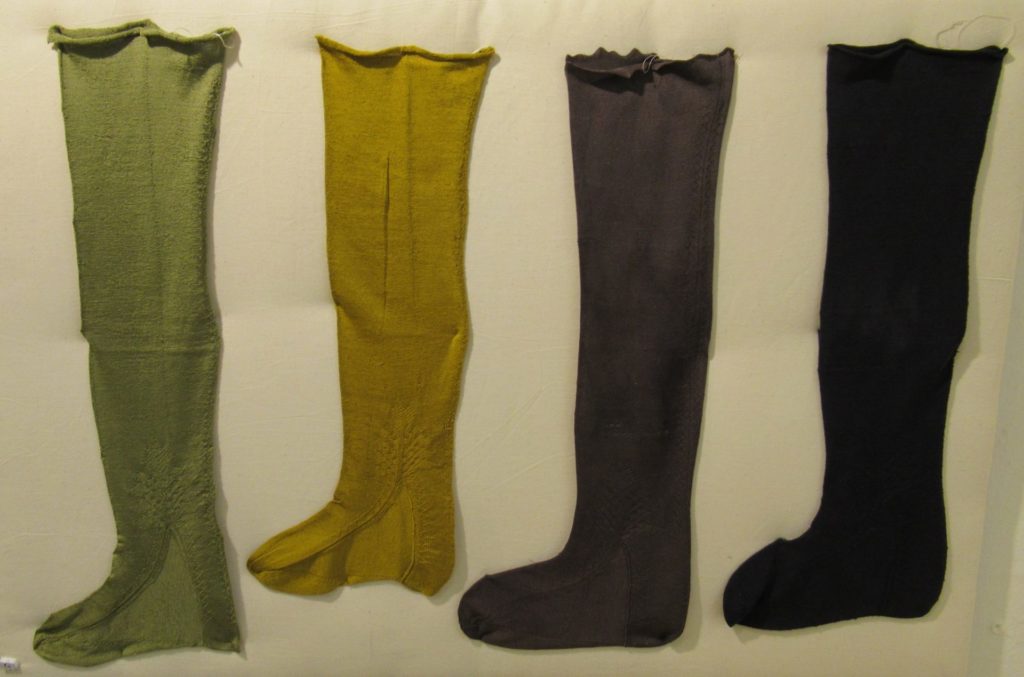
Replicating the shipwrecked stockings made it clear that they were probably meant to be worn by a man, because they were long enough to go over the knee, which was how men used to wear them at the time. Women wore theirs tied below the knee.
Well, that was my brief impression of the exhibition ‘Socks and Stockings’ at the TRC. I hope you now understand why I traveled all the way to Leiden to see some stockings. Do go and visit if you can – the exhibition is still on until December 19th 2019.
If you’re still not convinced that you should go – apart from these stockings, there are also many, many colourful and interesting socks to see. Maybe I’ll write more about those in my next post.
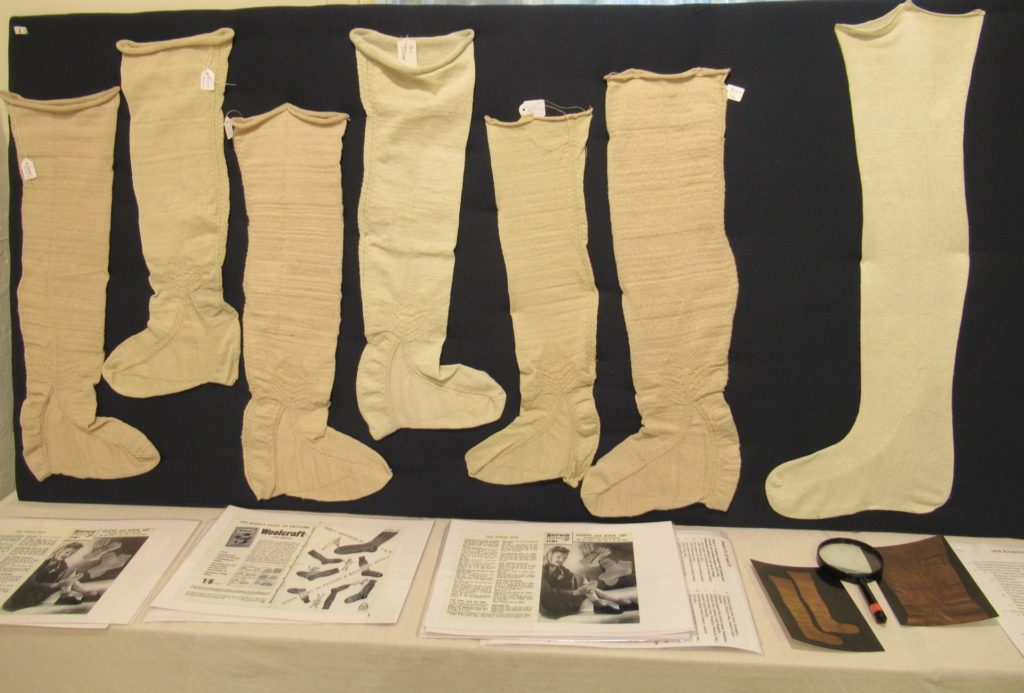
Links:
- If you’re unable to travel to Leiden or would like to read more, please visit the website of the Textile Research Centre, where the exhibition is held (Dutch and English).
- There’s also some information on the website of Chrystel Brandenburgh, the archaeologist involved in the project (Dutch only).
- The original stockings are temporarily housed at archaeology centre Huis van Hilde, for further research. They are not on display, but the website has a lot of interesting information (in Dutch, English and German).
- Eventually, the stockings and other finds will be displayed at Kaap Skil, the museum on the island of Texel. Their website has pictures of the original stockings and several interesting articles too (in Dutch, English and German).
For most of these websites, the best way to access the information is to enter ‘stockings’ or ‘kousen’ into the search menu.
Summer Walks Part II – Coast
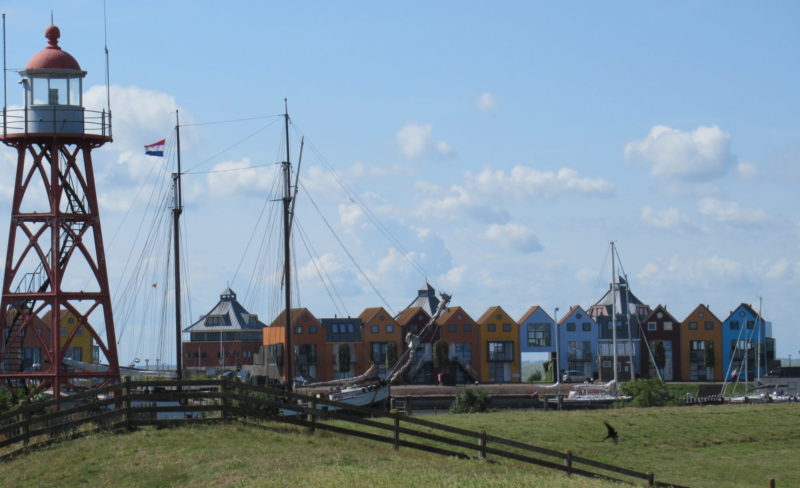
On a day that was too hot for walking through woods or across heathland, we thought a walk along the coast might be a good idea, with hopefully a refreshing breeze. So we set off for my native Friesland. Our starting-point was the old town of Stavoren (photo above), and our destination was Hindeloopen, another small harbour town. (It was a one-way walk – we took the train back.)
This isn’t the coast as in sea shore, but rather the coastline along the IJsselmeer, a former inland sea that was closed off around 1930 and is now a big freshwater lake. The dykes are still there, and our trail ran right across the top. Well, it wasn’t really a trail, just grass, but you get the idea.
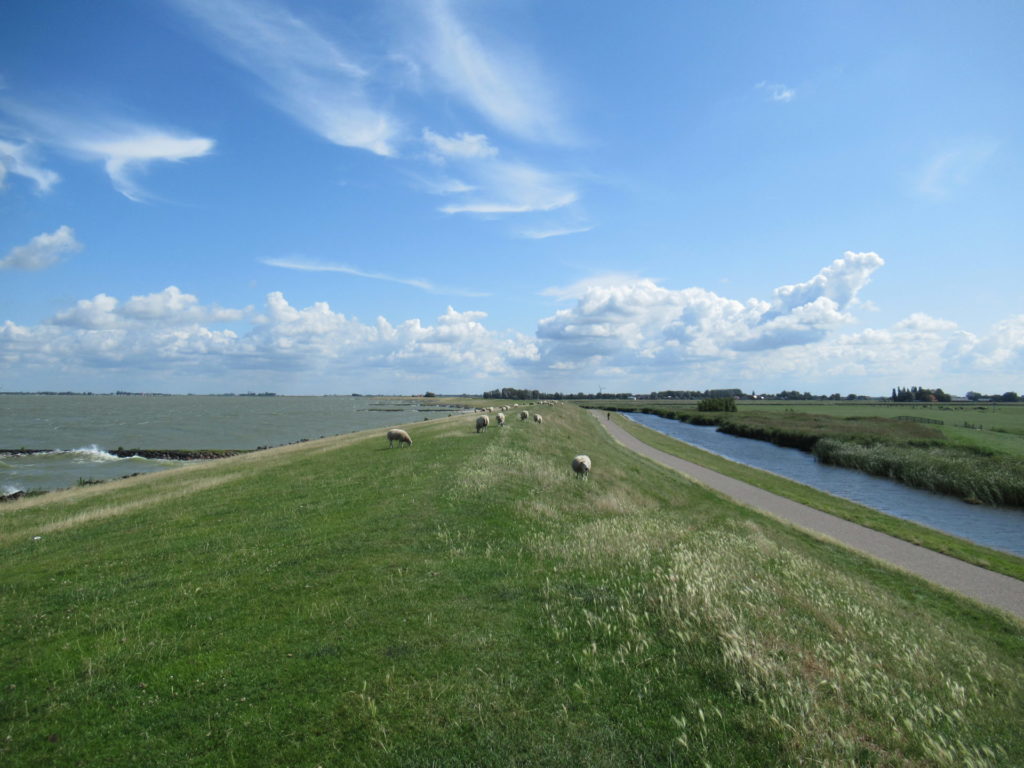
In reality the dyke is much steeper than it looks here. The narrow road on the right is a bicycle track. Nice when you’re cycling, because it’s sheltered from the prevailing wind. But not much fun when you’re walking, because you’d miss the lovely views over the lake.
With a delicious breeze from behind it was an ideal day for this walk. Looking to the left, we saw a choppy lake with some sailing boats.
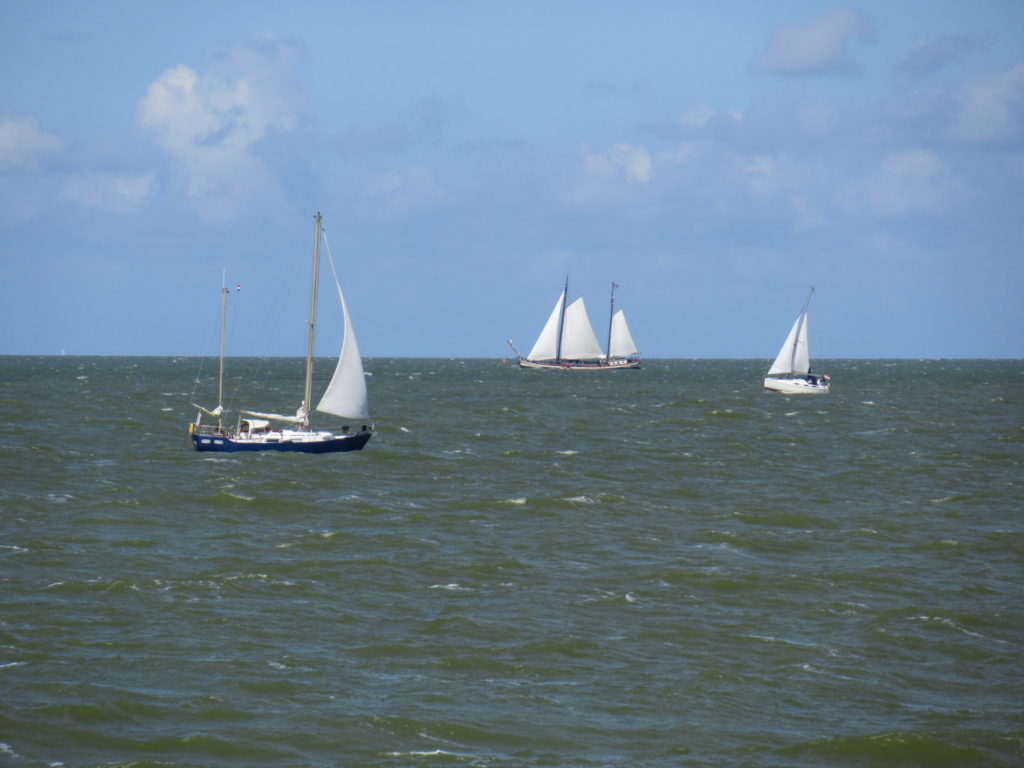
And looking to the right, we saw agricultural land, with some farms and modern windmills. Completely flat, with endless horizons.
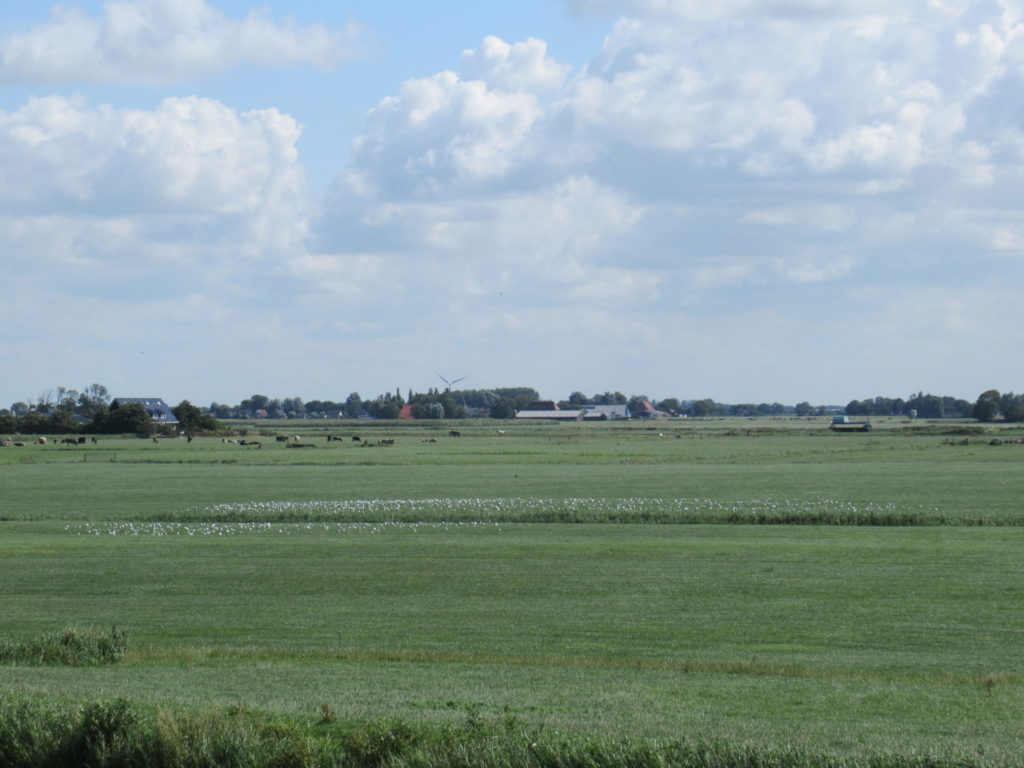
All along the dyke, there were lots of fences with stiles to climb.
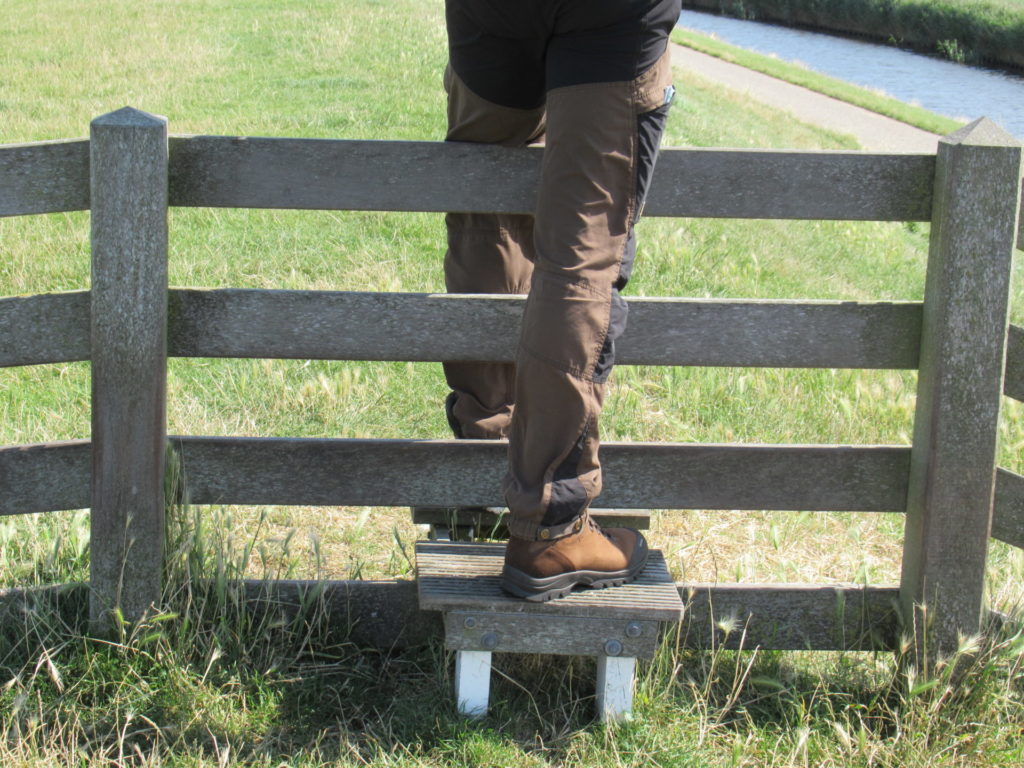
The fences are there to confine the Texel sheep to certain sections of the dyke. The sheep are kept company by water birds, like these black and white barnacle geese.
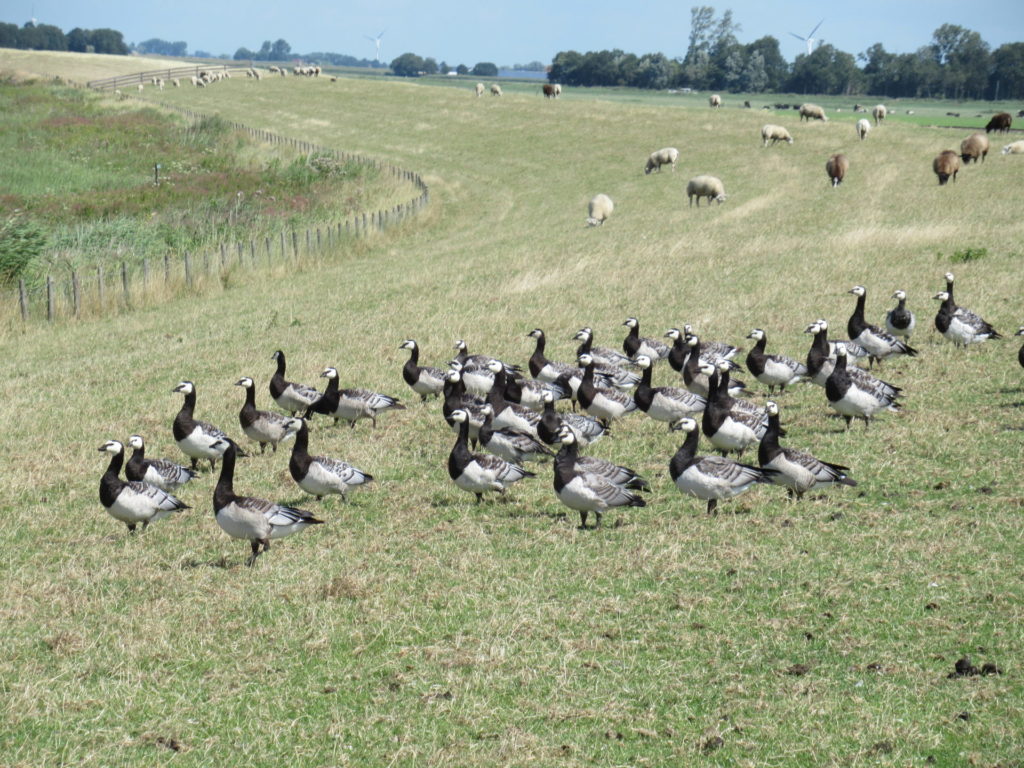
The sheep were not shy at all. They didn’t run away when we came close, like they usually do. We had to step around and over sheep and lambs lazing and grazing on our path. And some of the sheep were downright pushy. When we sat down on the grass to eat our sandwiches, they came begging for a share. They must have been fed by other walkers.
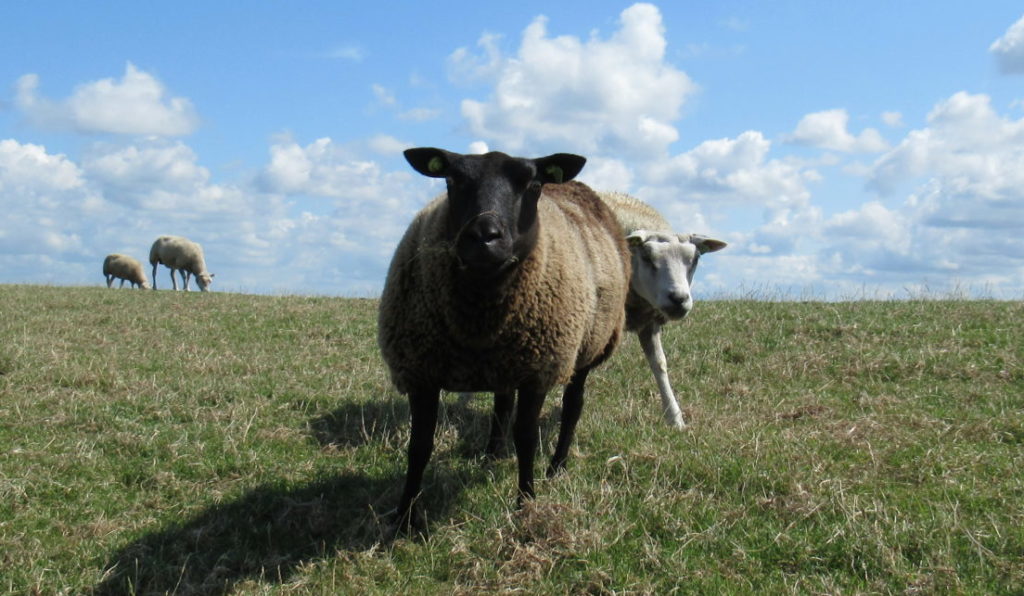
‘Come on, give us some of your bread,’ they seemed to say. And, ‘I really like the smell of that cheese.’ They refused to be shooed away and were so insistent, that in the end we got up and walked on, eating the rest of our lunch along the way.
In the distance we could already see our destination. It wasn’t just a perfect day for walking, but for wind and kite surfing, too.
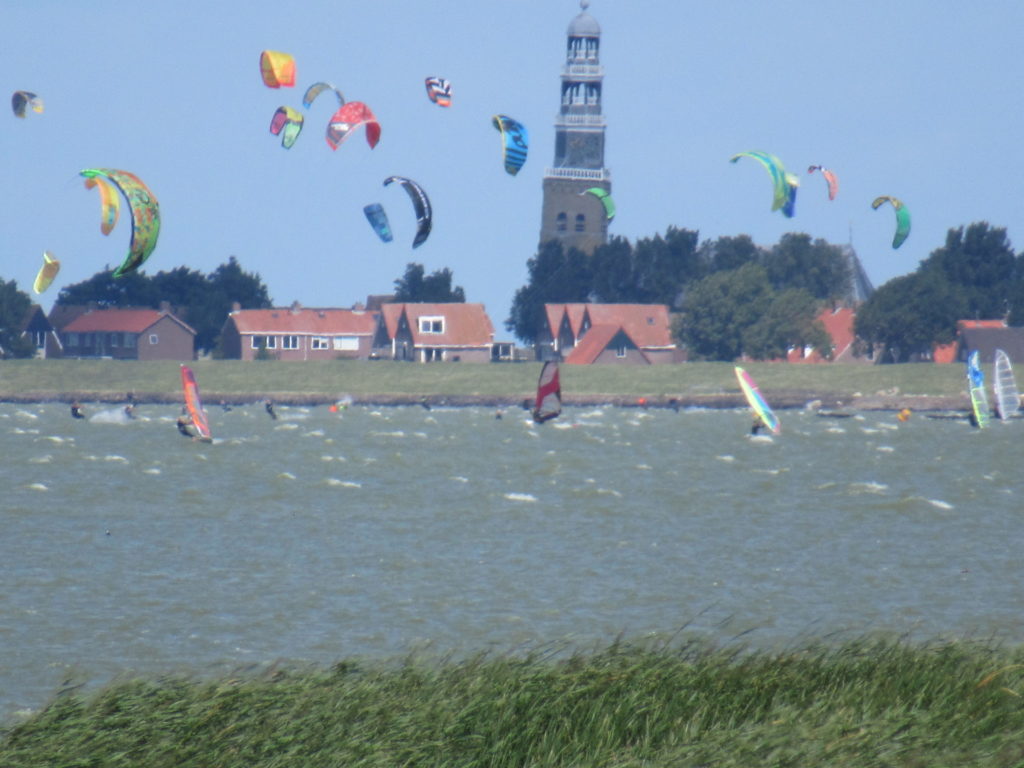
Against the big blue sky, Hindeloopen looked very small, with its church and the houses with their red roofs huddled behind the dyke. And, in fact, it is small now, with under 900 inhabitants. In the 17th and 18th centuries, when the lake was still a sea, it used to be an important harbour and trade centre, with three times the number of people and a fleet of around a hundred ships.
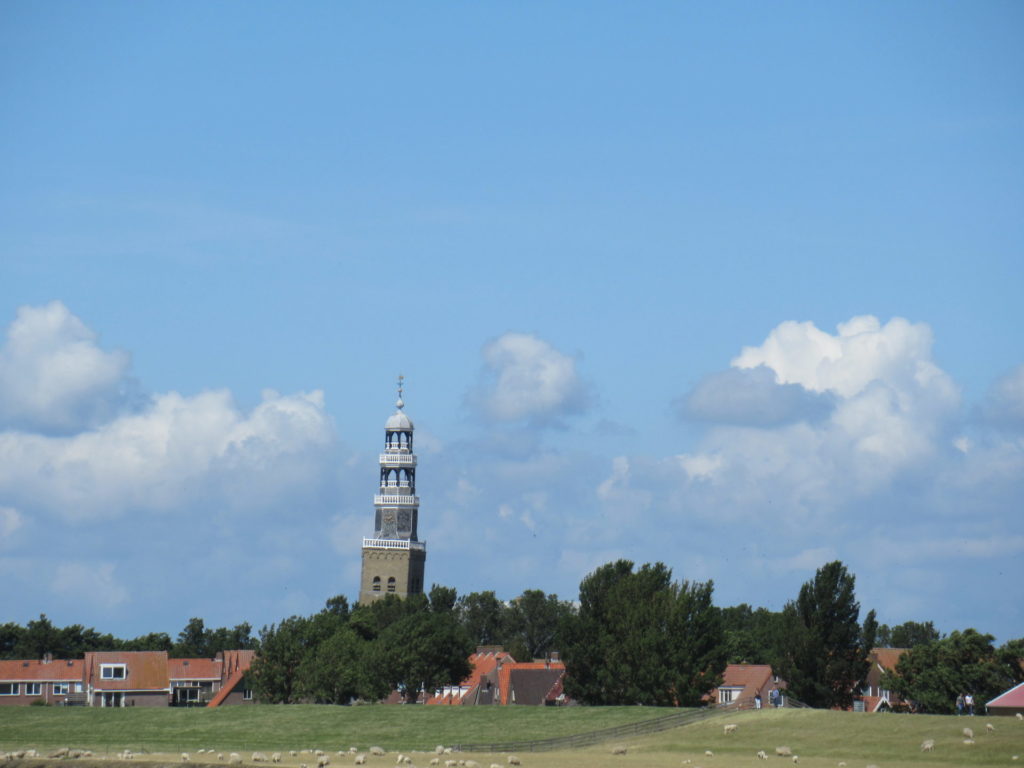
It’s nice to imagine merchant ships leaving and entering the town via the lock (photo below) that is now used by pleasure boats. On their outward-bound journeys they would be filled with gin and wool. And coming back from Scandinavia and Russia they would be carrying wood.
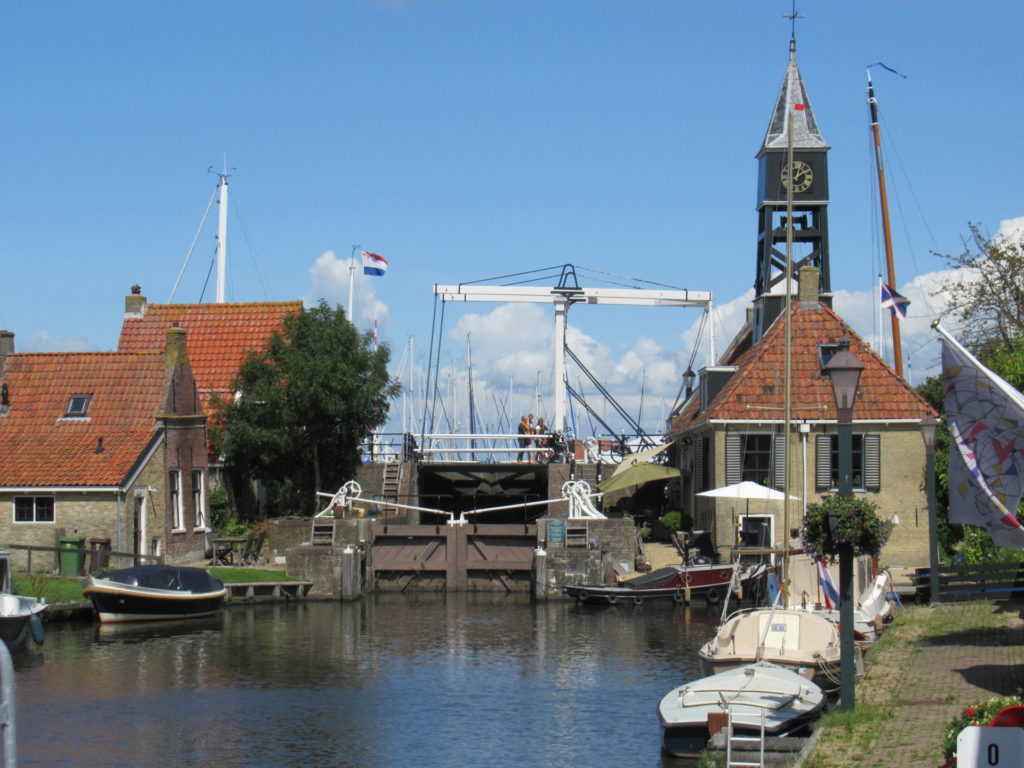
We slowly strolled through the old town centre and saw some monumental merchant’s houses – a sign of great wealth in earlier times.
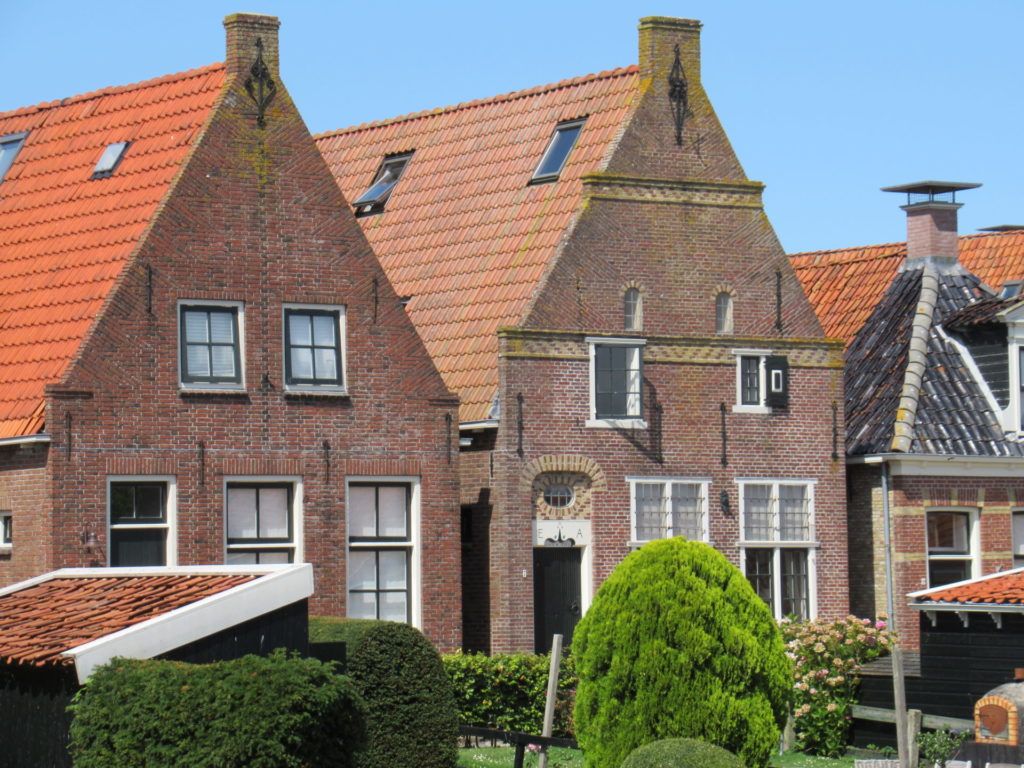
There was a museum, too, as well as several shops selling local traditional crafts. Hindeloopen is renowned for its decorative painting style, with garlands and stylized flowers on a red, green, blue or cream background. Here are several trays and a ‘butte’.
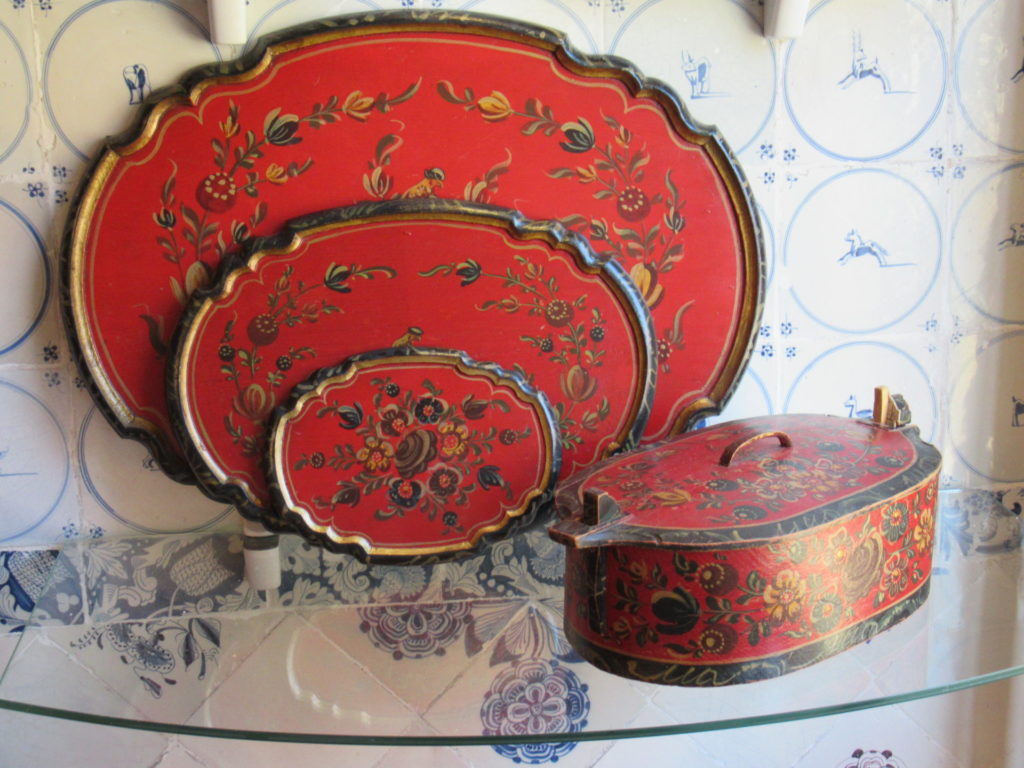
A butte is a traditional travelling case used by seamen for their personal belongings. I think it’s a thing of beauty and would like to own one someday. But as it’s all handmade, it has quite a hefty price tag. It’s not that it isn’t worth it, but it isn’t an amount I’d spend on a whim.
I came home with some more modest souvenirs – two pieces of fabric and two postcards.
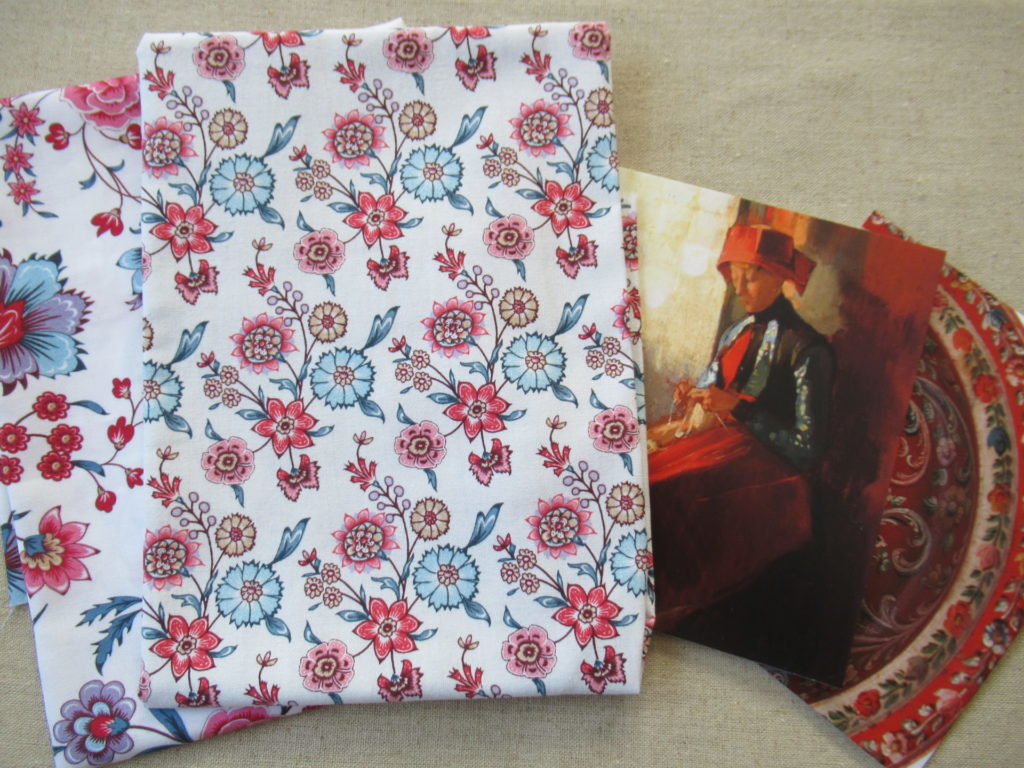
The fabrics are inspired by some of those used in the colourful traditional costumes of Hindeloopen. I don’t know what I’m going to use them for yet, but I’ll think of something.
One of the cards shows some of the typical decorative painting on a wooden platter. And the other shows a woman in traditional dress. (Unfortunately the postcard doesn’t tell us who the artist is.) In the painting, the fabrics are simplified to solid colours. In reality they would be flowered and checked, in mainly red, blue and white. There’s an picture of a complete costume on the town’s museum website.
And what is the woman doing? Knitting – what else?
